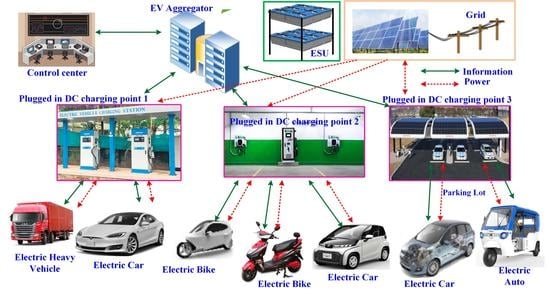Electric Vehicles Charging Stations’ Architectures, Criteria, Power Converters, and Control Strategies in Microgrids
Abstract
:1. Introduction
- The impacts of selection of charging stations, sizing of the charging systems, and selection of sources. The different sources connected should ensure a suitable charging system, made with different technologies like on-board and off-board chargers. Suitable charging station architecture and selection of sources will reduce costs, dimensions, weights, and power rating, among other factors.
- Charging stations require standards to connect charging cords, cables, and connectors. The implementation of charging stations with standards can maximize the utilization of charging stations.
- The cost and performance of a charger depends on the semiconducting devices and its arrangement. All of this impacts one’s choice, and the size of the charging system is based on the converter topology used for conversion and gain of the corresponding converter.
- A charging station with renewable energy reduces the demand in the existing grid system and reduces fossil fuel-based conversion of energy. In addition, the effective use of renewable sources and utilization of sources through energy management increases usage of the EV.
2. Architecture of Multi-Point EV Charging Stations
2.1. Isolated DC Microgrid for EV Charging
Isolated DC Microgrid Control Strategy
2.2. Grid-Connected, RES-Powered DC MG for EV Charging
2.3. RES-Powered DC Microgrid with Direct Connection of ESU
Modes of Operation and Control Algorithm
2.4. AC Bus Coupled Charging Station Architecture
AC Bus-Connected Charging and Discharging Control
2.5. Hybrid AC-DC Microgrid
2.5.1. AC and DC Charging Station and Its Control
2.5.2. Frequency Droop Control
2.5.3. Angle Droop Control
2.5.4. Communication-Based Control
2.6. Multiport Converter with DC Grid Interconnection
2.7. Multiport Converter with AC Grid Interconnection
3. Charging Station Standards and Levels
4. EV Charging Connectors
5. Power Electronic Converters for Charging Stations
5.1. DC-DC Converters
5.2. AC-DC Converters
6. Control Strategy of Charging Stations
6.1. Rule-Based Control
6.2. Fuzzy Logic Control of Charging Stations
7. Energy Management in DC Microgrid-Based Charging Stations
- ➢
- Development of an energy management strategy to control the power flow among available sources and charging terminals for effective utilization of the generated renewable power.
- ➢
- In a PV-powered charging station, the power produced by the PV is variable in nature and it creates a DC bus voltage variation in the microgrid, irrespective of overloading and irradiation on the PV.
- ➢
- The charging port with the closed loop control provides constant current and constant voltage charging, and reduces charging time.
7.1. Microgrid-Connected EV Charging Stations
7.1.1. Energy Management Modes
7.1.2. Experimental Implementation
- Mode 1: ESU and PV to EV charging (PPV ≤ 120 W).
- Mode 2: Particular EV charging by PV (PPV ≤ 120 W).
- Mode 3: Utility grid and PV-based ESU charging (PPV ≤ 120 W).
- Mode 4: Utility grid and PV-connected EV charging (PPV ≤ 120 W).
- Mode 5: Utility grid and PV-powered EV and ESU charging (120 W ≤ PPV ≤ 160 w)
- Mode 6: PV-powered EV charging (120 W ≤ PPV ≤ 160 W).
- Mode 7: Utility grid powering (120 W ≤ PPV ≤ 160 W).
- Mode 8: PV-powered EV and ESU charging (160 W ≤ PPV ≤ 230 W).
- Mode 9: PV-powered energy storage (PPV ≥ 230 W).
- Mode 10: Energy storage to EV charging (PPV < PPV MIN).
- Mode 11: EV to EV (V2V) charging (PPV < PPV MIN).
- 1.
- Mode 2: Particular EV Charging by PV (PPV ≤ 120 W)
- 2.
- Mode 9: PV-powered Energy Storage (PPV ≥ 230 W)
- 3.
- Mode-11: EV to EV (V2V) Charging (PPV < PPV MIN)
- ➢
- Even though the utility grid is fully loaded due to local demand and irradiation variation on PV, EV-charging is not delayed.
- ➢
- The 11 modes based on load and source availability offer EV charging terminals an uninterrupted supply for charging.
- ➢
- The total power demand is maintained by the available vehicle and ESU.
- ➢
- A MATLAB model was developed for the charging station to analyze different types of charging stations, including multiport offerings.
- ➢
- The experimental setup analyzes the practical feasibility of charging stations.
7.2. A DC Microgrid-Based Charging Station and Its IoT-Based Monitoring System
- ➢
- The cloud delivers a swapping battery condition report to the driver’s mobile device directly after detecting unusual conditions in the battery.
- ➢
- The battery swapping parameters’ detection and storage in the cloud helps develop the business model.
7.3. Energy Management Strategy for a DC Microgrid with Maximum Penetration of RES
- PG > PL (the priority load is the lighting load that charges during the day and discharges at night)
- PG = PL (the load is raised at 9 am to 10 am to generate power, load power is 440 W, load current is 2 A, and the generated power continuously supplies the load without any interruption)
- PG < PL (from 8 pm to 12 am, the load is considered to be 900 W and available generation is 600 W)
8. Challenges and Opportunities for Charging Station Infrastructures
8.1. Challenges
- Optimal location for electric vehicle charging stations: An ideal location is critical in reducing the range of anxiety experienced by electric vehicle buyers. Several factors influence the location of charging stations, including drivers’ satisfaction with charging, operators’ economic problems, vehicle power loss, power grid safety, and transportation system and traffic congestion.
- The following problems were assumed while conducting the research:
- Charging demand (mainly by BEV)
- Charging facility features
- Charging fees and electricity cost
- Cost of station installation, operation, maintenance, and land acquisition
- Development of fast charging, ultra-fast charging, and battery swapping stations to reduce EV-charging time.
- Provision of queue management based on the strategy at the charging station.
- To maintain energy balance, a proper grid integration structure with charging stations is required.
- A communication system between the charging point to EV and grid management and the ability to quickly identify a vehicle and make the billing process as simple as possible. Charge cost optimization by selecting the most appropriate time and charging rates. Optimize grid load by adjusting charger capacity in response to grid demand. Use V2G technology to support grid operation during peak loads.
- Energy storage technologies in EV charging stations, particularly fast and ultra-fast charging stations, support stable operation, and improve customer satisfaction. In order to define their contribution level in terms of energy supply for EV-charging, ESS sizing is critical in charging station infrastructure.
- Architecture: Efficiency of the existing utility grid system is decreased due to EV charging loads.
- Adaptation of renewable sources: High cost of installation of renewable energy sources and compliance with multiple charging protocols.
- Accommodation of land space: The promotions of EV charging stations with renewable energy sources occupy large land areas that can increase the cost of installation.
- Energy management: There are many challenges in EMS, such as low efficiency at charging port, reliability and prediction of batteries from overcharging.
- DC link interfacing: Interfacing of renewables creates voltage fluctuation in DC links and requires a regulated output from the sources.
- Selection of converters: Number of switching devices and storage devices in converter topology lead to more losses in conversion. In addition, control of the converter requires a suitable control.
- Control scheme: The control methodology selection for a suitable power rating application requires detailed analysis and dedicated control.
8.2. Opportunities
- Optimal selection of charging stations based on the demand for charging (primarily from BEVs), charging facility features, fees and electricity costs, station installation, operation, and maintenance costs, as well as land acquisition costs; there is literature available on optimization.
- The optimal development of charging infrastructure necessitates careful planning in terms of charging station location and size. A large charging station can accommodate a greater number of chargers to accommodate more EVs; nevertheless, it will also require more electrical energy and construction costs.
- The charging infrastructure requirements are highly dependent on EV battery sizes and power rates, both of which are expected to rise in the future.
- Development of fast-charging, ultra-fast charging, and battery swapping stations are being developed to reduce EV-charging time.
- The rate of EV adoption has a significant impact on the development of fast- and ultra-fast charging stations, as well as the profitability of their operation.
- It is critical to regulate and schedule the available charging stations in order to charge an electric vehicle. This will aid in the strategic management of EV queues at charging stations. The management of queues will be aided by an effective communication network.
- Several communication protocols and standards are available for billing and managing the charging.
- Architecture: The charging station, by connecting renewable sources and bidirectional power converter in the charging station architecture, meets grid demand through V2G technology.
- Adaptation of renewable sources: Charging pricing decreases, emission reduces, and the utility grid does not overload.
- Accommodation of land space: The installations of more charging stations lead to an increase in the number of vehicles on the road.
- Energy management: The energy management system in charging stations with renewable sources makes full use of solar energy; thus, the operating cost is reduced, resulting in maximum benefit.
- DC link interfacing: EV-charging depends on storage devices; effectively connected DC energy storages provide better efficiency.
- Selection of converters: A suitable converter and control strategy leads to increased efficiency and reduces charging time.
- Control scheme: The conventional and intelligent control, the optimization algorithm, is used to provide better control.
9. Conclusions
- In AC microgrids, the controller can manage frequency, voltage regulation, and real and reactive power control.
- The DC microgrid-based charging station is more suitable due to conversion losses.
- The energy storage unit in the charging station provides uninterrupted EV-charging and ESU provides an option for effective usage of renewable energy sources.
- ESU integration with microgrids through dedicated converters enables fast charging and discharging.
- DC microgrid-based charging station control through DC link voltage and power prediction provides better efficiency.
- Controlling of microgrids through fuzzy logic and optimization technique-based energy management strategy provides better regulation and optimal management of fast charging.
- Charging side converters with bidirectional power flow support grid voltage regulation through constant current and voltage charging.
Author Contributions
Funding
Data Availability Statement
Conflicts of Interest
References
- Woodcock, J.; Edwards, P.; Tonne, C.; Armstrong, B.G.; Ashiru, O.; Banister, D.; Beevers, S.; Chalabi, Z.; Chowdhury, Z.; Cohen, A.; et al. Public health benefits of strategies to reduce greenhouse-gas emissions: Urban land transport. Lancet 2009, 374, 1930–1943. [Google Scholar] [CrossRef]
- Pepermans, G.; Driesen, J.; Haeseldonckx, D.; Belmans, R.; D’Haeseleer, W. Distributed generation: Definition, benefits and issues. Energy Policy 2005, 33, 787–798. [Google Scholar] [CrossRef]
- Lasseter, R.; Paigi, P. Microgrid: A conceptual solution. In Proceedings of the 2004 IEEE 35th Annual Power Electronics Specialists Conference (IEEE Cat. No.04CH37551), Aachen, Germany, 20–25 June 2004; Volume 6, pp. 4285–4290. [Google Scholar]
- Schroeder, A.; Traber, T. The economics of fast charging infrastructure for electric vehicles. Energy Policy 2012, 43, 136–144. [Google Scholar] [CrossRef]
- Richardson, P.; Flynn, D.; Keane, A. Local Versus Centralized Charging Strategies for Electric Vehicles in Low Voltage Distribution Systems. IEEE Trans. Smart Grid 2012, 3, 1020–1028. [Google Scholar] [CrossRef]
- Liu, L.; Kong, F.; Liu, X.; Peng, Y.; Wang, Q. A review on electric vehicles interacting with renewable energy in smart grid. Renew. Sustain. Energy Rev. 2015, 51, 648–661. [Google Scholar] [CrossRef]
- Clement-Nyns, K.; Haesen, E.; Driesen, J. The Impact of Charging Plug-In Hybrid Electric Vehicles on a Residential Distribution Grid. IEEE Trans. Power Syst. 2009, 25, 371–380. [Google Scholar] [CrossRef] [Green Version]
- Kempton, W.; Tomić, J. Vehicle-to-grid power implementation: From stabilizing the grid to supporting large-scale renewable energy. J. Power Sources 2005, 144, 280–294. [Google Scholar] [CrossRef]
- Dragicevic, T.; Lu, X.; Vasquez, J.C.; Guerrero, J. DC Microgrids—Part II: A Review of Power Architectures, Applications, and Standardization Issues. IEEE Trans. Power Electron. 2016, 31, 3528–3549. [Google Scholar] [CrossRef] [Green Version]
- Kuperman, A.; Levy, U.; Goren, J.; Zafransky, A.; Savernin, A. Battery Charger for Electric Vehicle Traction Battery Switch Station. IEEE Trans. Ind. Electron. 2013, 60, 5391–5399. [Google Scholar] [CrossRef]
- Yang, B.; Li, W.; Zhao, Y.; He, X. Design and Analysis of a Grid-Connected Photovoltaic Power System. IEEE Trans. Power Electron. 2010, 25, 992–1000. [Google Scholar] [CrossRef]
- Che, L.; Shahidehpour, M.; AlAbdulwahab, A.; Al-Turki, Y. Hierarchical Coordination of a Community Microgrid with AC and DC Microgrids. IEEE Trans. Smart Grid 2015, 6, 3042–3051. [Google Scholar] [CrossRef]
- Bajaj, M.; Singh, A. Grid integrated renewable DG systems: A review of power quality challenges and state-of-the-art mitigation techniques. Int. J. Energy Res. 2020, 44, 26–69. [Google Scholar] [CrossRef]
- Basak, P.; Chowdhury, S.; Dey, S.H.N. A literature review on integration of distributed energy resources in the perspective of control, protection and stability of microgrid. Renew. Sustain. Energy Rev. 2012, 16, 5545–5556. [Google Scholar] [CrossRef]
- Hatziargyriou, N.; Asano, H.; Iravani, R.; Marnay, C. Microgrids. IEEE Power Energy Mag. 2007, 5, 78–94. [Google Scholar] [CrossRef]
- Guerrero, J.; Vasquez, J.C.; Matas, J.; de Vicuña, L.G.; Castilla, M. Hierarchical Control of Droop-Controlled AC and DC Microgrids—A General Approach Toward Standardization. IEEE Trans. Ind. Electron. 2011, 58, 158–172. [Google Scholar] [CrossRef]
- Oleynik, V.; Albul, G. Multipurpose, Universal Converter with Battery Control and Real-Time Power Factor Correction. U.S. Patent 9,178,354, 3 November 2015. [Google Scholar]
- Tan, L.; Zhu, N.; Wu, B. An Integrated Inductor for Eliminating Circulating Current of Parallel Three-Level DC-DC Converter-Based EV Fast Charger. IEEE Trans. Ind. Electron. 2015, 63, 1362–1371. [Google Scholar] [CrossRef]
- Lee, C.-T.; Chu, C.-C.; Cheng, P.-T. A New Droop Control Method for the Autonomous Operation of Distributed Energy Resource Interface Converters. IEEE Trans. Power Electron. 2013, 28, 1980–1993. [Google Scholar] [CrossRef]
- Li, F.; Qiao, W.; Sun, H.; Wan, H.; Wang, J.; Xia, Y.; Xu, Z.; Zhang, P. Smart Transmission Grid: Vision and Framework. IEEE Trans. Smart Grid 2010, 1, 168–177. [Google Scholar] [CrossRef]
- Gurin, M.H. Hybrid Power Generation and Energy Storage System. U.S. Patent 8,099,198, 17 January 2012. [Google Scholar]
- Mak, H.-Y.; Rong, Y.; Shen, Z.-J.M. Infrastructure Planning for Electric Vehicles with Battery Swapping. Manag. Sci. 2013, 59, 1557–1575. [Google Scholar] [CrossRef] [Green Version]
- Van Haaren, R. Assessment of Electric Cars’ Range Requirements and Usage Patterns Based on Driving Behavior Recorded in the National Household Travel Survey of 2009; Earth and Environmental Engineering Department, Columbia University; Fu Foundation School of Engineering and Applied Science: New York, NY, USA, 2009; Volume 51, p. 53. [Google Scholar]
- Available online: https://www.istockphoto.com/photos/electric-vehicle-charging-station (accessed on 2 June 2021).
- Talukdar, B.; Deka, B. An Approach to Reliability, Availability and Maintainability Analysis of a Plug-In Electric Vehicle. World Electr. Veh. J. 2021, 12, 34. [Google Scholar] [CrossRef]
- Xu, G.; Du, X.; Li, Z.; Zhang, X.; Zheng, M.; Miao, Y.; Gao, Y.; Liu, Q. Reliability design of battery management system for power battery. Microelectron. Reliab. 2018, 88–90, 1286–1292. [Google Scholar] [CrossRef]
- Available online: https://globalnews.ca/news/2171804/uk-to-test-roads-that-charge-electric-cars-as-they-drive/ (accessed on 2 June 2021).
- Chatterjee, S.; Iyer, A.; Bharatiraja, C.; Vaghasia, I.; Rajesh, V. Design Optimisation for an Efficient Wireless Power Transfer System for Electric Vehicles. Energy Procedia 2017, 117, 1015–1023. [Google Scholar] [CrossRef]
- McDonough, M. Integration of Inductively Coupled Power Transfer and Hybrid Energy Storage System: A Multiport Power Electronics Interface for Battery-Powered Electric Vehicles. IEEE Trans. Power Electron. 2015, 30, 6423–6433. [Google Scholar] [CrossRef]
- Park, M.; Nguyen, V.T.; Yu, S.-D.; Yim, S.-W.; Park, K.; Min, B.D.; Kim, S.-D.; Cho, J.G. A study of wireless power transfer topologies for 3.3 kW and 6.6 kW electric vehicle charging infrastructure. In Proceedings of the 2016 IEEE Transportation Electrification Conference and Expo, Asia-Pacific (ITEC Asia-Pacific), Busan, Korea, 1–4 June 2016; pp. 689–692. [Google Scholar]
- Chittoor, P.K.; Chokkalingam, B.; Mihet-Popa, L. A Review on UAV Wireless Charging: Fundamentals, Applications, Charging Techniques and Standards. IEEE Access 2021, 9, 69235–69266. [Google Scholar] [CrossRef]
- Krishnamoorthy, R.; Krishnan, K.; Chokkalingam, B.; Padmanaban, S.; Leonowicz, Z.; Holm-Nielsen, J.B.; Mitolo, M. Systematic Approach for State-of-the-Art Architectures and System-on-chip Selection for Heterogeneous IoT Applications. IEEE Access 2021, 9, 25594–25622. [Google Scholar] [CrossRef]
- Available online: https://www.motorcyclenews.com/news/electric-motorbike-swappable-batteries/ (accessed on 2 June 2021).
- Rahman, I.; Vasant, P.M.; Singh, B.S.M.; Abdullah-Al-Wadud, M.; Adnan, N. Review of recent trends in optimization techniques for plug-in hybrid, and electric vehicle charging infrastructures. Renew. Sustain. Energy Rev. 2016, 58, 1039–1047. [Google Scholar] [CrossRef]
- Kisacikoglu, M.C.; Kesler, M.; Tolbert, L. Single-Phase On-Board Bidirectional PEV Charger for V2G Reactive Power Operation. IEEE Trans. Smart Grid 2015, 6, 767–775. [Google Scholar] [CrossRef]
- Furiya, K.; Omura, N.; Nagano, H.; Nishimura, K.; Ueda, A.; Tokura, S. Parallel-connected bilayer coil for a 3.3-kW electric vehicle wireless charging system. In Proceedings of the 2017 IEEE Wireless Power Transfer Conference (WPTC), Taipei, Taiwan, 10–12 May 2017. [Google Scholar]
- Mwasilu, F.; Justo, J.J.; Kim, E.-K.; Do, T.; Jung, J.-W. Electric vehicles and smart grid interaction: A review on vehicle to grid and renewable energy sources integration. Renew. Sustain. Energy Rev. 2014, 34, 501–516. [Google Scholar] [CrossRef]
- García-Vera, Y.E.; Dufo-López, R.; Bernal-Agustín, J.L. Optimization of Isolated Hybrid Microgrids with Renewable Energy Based on Different Battery Models and Technologies. Energies 2020, 13, 581. [Google Scholar] [CrossRef] [Green Version]
- Thiyagarajan, S.; Sonthalia, A.; Geo, V.E.; Chokkalingam, B. Effect of waste exhaust heat on hydrogen production and its utilization in CI engine. Int. J. Hydrogen Energy 2020, 45, 5987–5996. [Google Scholar] [CrossRef]
- Al Badwawi, R.; Abusara, M.; Mallick, T. A Review of Hybrid Solar PV and Wind Energy System. Smart Sci. 2015, 3, 127–138. [Google Scholar] [CrossRef]
- Suresh, K.; Bharatiraja, C.; Chellammal, N.; Tariq, M.; Chakrabortty, R.K.; Ryan, M.J.; Alamri, B. A Multifunctional Non-Isolated Dual Input-Dual Output Converter for Electric Vehicle Applications. IEEE Access 2021, 9, 64445–64460. [Google Scholar] [CrossRef]
- Bhutto, D.K.; Ansari, J.A.; Bukhari, S.S.H.; Chachar, F.A. WIND ENERGY CONVERSION SYSTEMS (WECS) GENERATORS: A REVIEW. In Proceedings of the 2019 2nd International Conference on Computing, Mathematics and Engineering Technologies (iCoMET), Sukkur, Pakistan, 30–31 January 2019; pp. 1–6. [Google Scholar]
- IEC. IEC. 61643-11: Low-Voltage Surge Protective Devices-Part 11: Surge Protective Devices Connected to Low-Voltage Power Distribution Systems-Requirements and Test Methods; BSI: London, UK, 2011. [Google Scholar]
- Kersten, A.; Rodionov, A.; Kuder, M.; Hammarström, T.; Lesnicar, A.; Thiringer, T. Review of Technical Design and Safety Requirements for Vehicle Chargers and Their Infrastructure According to National Swedish and Harmonized European Standards. Energies 2021, 14, 3301. [Google Scholar] [CrossRef]
- Samson, N. Smart Plug-Optimization of design and material regarding environmental aspects: Mechanical design of an environmentally friendly Smart Plug. Master’s Thsesis, Karlstad University, Karlstad, Suedia, 2020. [Google Scholar]
- Musavi, F.; Edington, M.; Eberle, W.; Dunford, W.G. Evaluation and Efficiency Comparison of Front End AC-DC Plug-in Hybrid Charger Topologies. IEEE Trans. Smart Grid 2012, 3, 413–421. [Google Scholar] [CrossRef]
- Anand, S.; Fernandes, B.G. Optimal voltage level for DC microgrids. In Proceedings of the IECON 2010–36th Annual Conference on IEEE Industrial Electronics Society; IEEE: Piscataway, NJ, USA, 2010; pp. 3034–3039. [Google Scholar]
- Sharma, A.; Srinivasan, D.; Trivedi, A. A Decentralized Multiagent System Approach for Service Restoration Using DG Islanding. IEEE Trans. Smart Grid 2015, 6, 2784–2793. [Google Scholar] [CrossRef]
- Gamboa, G.; Hamilton, C.; Kerley, R.; Elmes, S.; Arias, A.; Shen, J.; Batarseh, I. Control strategy of a multi-port, grid connected, direct-DC PV charging station for plug-in electric vehicles. In 2010 IEEE Energy Conversion Congress and Exposition; IEEE: Piscataway, NJ, USA, 2010; pp. 1173–1177. [Google Scholar]
- Ma, T.T.H.; Yahoui, H.; Vu, H.G.; Siauve, N.; Morel, H. A Control Strategy of DC Building Microgrid Connected to the Neighborhood and AC Power Network. Buildings 2017, 7, 42. [Google Scholar] [CrossRef]
- Barker, P.P.; De Mello, R. Determining the impact of distributed generation on power systems. I. Radial distribution systems. In Proceedings of the 2000 Power Engineering Society Summer Meeting (Cat. No.00CH37134); Institute of Electrical and Electronics Engineers (IEEE): Piscataway, NJ, USA, 2002; pp. 1645–1656. [Google Scholar]
- Clairand, J.-M.; Álvarez-Bel, C.; Rodríguez-García, J.; Escrivá-Escrivá, G. Impact of Electric Vehicle Charging Strategy on the Long-Term Planning of an Isolated Microgrid. Energies 2020, 13, 3455. [Google Scholar] [CrossRef]
- Guerrero, J.; Chandorkar, M.; Lee, T.-L.; Loh, P.C. Advanced Control Architectures for Intelligent Microgrids—Part I: Decentralized and Hierarchical Control. IEEE Trans. Ind. Electron. 2013, 60, 1254–1262. [Google Scholar] [CrossRef] [Green Version]
- Majumder, R.; Ghosh, A.; Ledwich, G.; Zare, F. Power Management and Power Flow Control with Back-to-Back Converters in a Utility Connected Microgrid. IEEE Trans. Power Syst. 2010, 25, 821–834. [Google Scholar] [CrossRef] [Green Version]
- Queiroz, J.; Dias, A.; Leitao, P. Predictive data analytics for agent-based management of electrical micro grids. In Proceedings of the IECON 2015–41st Annual Conference of the IEEE Industrial Electronics Society, Yokohama, Japan, 9–12 November 2015; pp. 4684–4689. [Google Scholar]
- Wang, B.; Sechilariu, M.; Locment, F. Intelligent DC Microgrid with Smart Grid Communications: Control Strategy Consideration and Design. IEEE Trans. Smart Grid 2012, 3, 2148–2156. [Google Scholar] [CrossRef]
- Kanchev, H.; Colas, F.; Lazarov, V.; Francois, B. Emission reduction and economical optimization of an urban microgrid operation including dispatched PV-based active generators. IEEE Trans. Sustain. Energy 2014, 5, 1397–1405. [Google Scholar] [CrossRef] [Green Version]
- Ms, K.; Nattuthurai, S.; Chokkalingam, B.; Muthusamy, S.; Cherukupalli, K. Development of ripple reduced solar photovoltaic regulators using boomerang sliding mode control strategy. Int. J. Circuit Theory Appl. 2021. [Google Scholar] [CrossRef]
- Panchu, S.J.; Raju, K.; Swart, H.C.; Chokkalingam, B.; Maaza, M.; Henini, M.; Moodley, M.K. Luminescent MoS2 Quantum Dots with Tunable Operating Potential for Energy-Enhanced Aqueous Supercapacitors. ACS Omega 2021, 6, 4542–4550. [Google Scholar] [CrossRef] [PubMed]
- You, P.; Yang, Z.; Chow, M.-Y.; Sun, Y. Optimal Cooperative Charging Strategy for a Smart Charging Station of Electric Vehicles. IEEE Trans. Power Syst. 2016, 31, 2946–2956. [Google Scholar] [CrossRef]
- Atawi, I.; Hendawi, E.; Zaid, S. Analysis and Design of a Standalone Electric Vehicle Charging Station Supplied by Photovoltaic Energy. Processes 2021, 9, 1246. [Google Scholar] [CrossRef]
- Sánchez-Sáinz, H.; Vázquez, C.A.G.; Iborra, F.L.; Fernández-Ramírez, L.M. Methodology for the Optimal Design of a Hybrid Charging Station of Electric and Fuel Cell Vehicles Supplied by Renewable Energies and an Energy Storage System. Sustainability 2019, 11, 5743. [Google Scholar] [CrossRef] [Green Version]
- Dos Santos, L.T.; Sechilariu, M.; Locment, F. Day-ahead microgrid optimal self-scheduling: Comparison between three methods applied to isolated DC microgrid. In Proceedings of the IECON 2014–40th Annual Conference of the IEEE Industrial Electronics Society, Dallas, TX, USA, 29 October–1 November 2014; pp. 2010–2016. [Google Scholar]
- Kharrich, M.; Kamel, S.; Ellaia, R.; Akherraz, M.; Alghamdi, A.; Abdel-Akher, M.; Eid, A.; Mosaad, M. Economic and Ecological Design of Hybrid Renewable Energy Systems Based on a Developed IWO/BSA Algorithm. Electronics 2021, 10, 687. [Google Scholar] [CrossRef]
- Bhargavi, K.M.; Jayalakshmi, N.S. A New Control Strategy for Plug-in Electric Vehicle of DC Microgrid with PV and Wind Power Integration. J. Electr. Eng. Technol. 2019, 14, 13–25. [Google Scholar] [CrossRef]
- Rahman, S.; Hossain, M.J.; Rafi, F.H.M.; Lu, J. EV charging in a commercial hybrid AC/DC microgrid: Configuration, control and impact analysis. In Proceedings of the 2016 Australasian Universities Power Engineering Conference (AUPEC); IEEE: Piscataway, NJ, USA, 2016; pp. 1–6. [Google Scholar]
- Kamalesh, M.; Senthilnathan, N.; Bharatiraja, C. Design of a Novel Boomerang Trajectory for Sliding Mode Controller. Int. J. Control. Autom. Syst. 2020, 18, 2917–2928. [Google Scholar] [CrossRef]
- Karthikeyan, M.; Elavarasu, R.; Ramesh, P.; Bharatiraja, C.; Sanjeevikumar, P.; Mihet-Popa, L.; Mitolo, M. A Hybridization of Cuk and Boost Converter Using Single Switch with Higher Voltage Gain Compatibility. Energies 2020, 13, 2312. [Google Scholar] [CrossRef]
- Savio, D.A.; Juliet, V.A.; Chokkalingam, B.; Padmanaban, S.; Holm-Nielsen, J.B.; Blaabjerg, F. Photovoltaic Integrated Hybrid Microgrid Structured Electric Vehicle Charging Station and Its Energy Management Approach. Energies 2019, 12, 168. [Google Scholar] [CrossRef] [Green Version]
- Ramesh, K.; Bharatiraja, C.; Raghu, S.; Vijayalakshmi, G.; Sambanthan, P. Design and Implementation of Real Time Charging Optimization for Hybrid Electric Vehicles. Int. J. Power Electron. Drive Syst. 2016, 7, 1261–1268. [Google Scholar] [CrossRef]
- Derakhshandeh, S.Y.; Masoum, A.S.; Deilami, S.; Masoum, M.A.S.; Golshan, M.E.H. Coordination of Generation Scheduling with PEVs Charging in Industrial Microgrids. IEEE Trans. Power Syst. 2013, 28, 3451–3461. [Google Scholar] [CrossRef]
- Liu, Y.; Tang, Y.; Shi, J.; Shi, X.; Deng, J.; Gong, K. Application of Small-Sized SMES in an EV Charging Station With DC Bus and PV System. IEEE Trans. Appl. Supercond. 2014, 25, 1–6. [Google Scholar] [CrossRef]
- Gundabathini, R.; Pindoriya, N.M. Improved Control Strategy for Bidirectional Single Phase AC-DC Converter in Hybrid AC/DC Microgrid. Electr. Power Compon. Syst. 2017, 45, 2293–2303. [Google Scholar] [CrossRef]
- Bhatti, A.R.; Salam, Z.; Aziz, M.J.A.; Yee, K.P. A critical review of electric vehicle charging using solar photovoltaic. Int. J. Energy Res. 2016, 40, 439–461. [Google Scholar] [CrossRef]
- Fretzen, U.; Ansarin, M.; Brandt, T. Temporal city-scale matching of solar photovoltaic generation and electric vehicle charging. Appl. Energy 2021, 282, 116160. [Google Scholar] [CrossRef]
- Kamaraj, V.; Chellammal, N.; Chokkalingam, B.; Munda, J.L. Minimization of Cross-Regulation in PV and Battery Connected Multi-Input Multi-Output DC to DC Converter. Energies 2020, 13, 6534. [Google Scholar] [CrossRef]
- Periyanayagam, M.; Velu, S.K.; Chokkalingam, B.; Padmanaban, S.; Mihet-Popa, L.; Adedayo, Y. A Modified High Voltage Gain Quasi-Impedance Source Coupled Inductor Multilevel Inverter for Photovoltaic Application. Energies 2020, 13, 874. [Google Scholar] [CrossRef] [Green Version]
- Gunasekaran, M.; Mohamed Ismail, H.; Chokkalingam, B.; Mihet-Popa, L.; Padmanaban, S. Energy Management Strategy for Rural Communities’ DC Micro Grid Power System Structure with Maximum Penetration of Renewable Energy Sources. Appl. Sci. 2018, 8, 585. [Google Scholar] [CrossRef] [Green Version]
- Goli, P.; Shireen, W. PV powered smart charging station for PHEVs. Renew. Energy 2014, 66, 280–287. [Google Scholar] [CrossRef]
- Zhao, J.; Kucuksari, S.; Mazhari, E.; Son, Y.-J. Integrated analysis of high-penetration PV and PHEV with energy storage and demand response. Appl. Energy 2013, 112, 35–51. [Google Scholar] [CrossRef]
- Sun, K.; Zhang, L.; Xing, Y.; Guerrero, J. A Distributed Control Strategy Based on DC Bus Signaling for Modular Photovoltaic Generation Systems with Battery Energy Storage. IEEE Trans. Power Electron. 2011, 26, 3032–3045. [Google Scholar] [CrossRef] [Green Version]
- Ms, K.; Nattuthurai, S.; Chokkalingam, B.; Mihet-Popa, L. Mitigation of circulating current with effective energy management in low-power PV-FC-battery-microgrid. Int. Trans. Electr. Energy Syst. 2021, 31, e12899. [Google Scholar] [CrossRef]
- Gurkaynak, Y.; Khaligh, A. Control and Power Management of a Grid Connected Residential Photovoltaic System with Plug-in Hybrid Electric Vehicle (PHEV) Load. In Proceedings of the 2009 Twenty-Fourth Annual IEEE Applied Power Electronics Conference and Exposition, Washington, DC, USA, 15–19 February 2009; pp. 2086–2091. [Google Scholar]
- Ma, T.; Mohammed, O. Optimal Charging of Plug-in Electric Vehicles for a Car-Park Infrastructure. IEEE Trans. Ind. Appl. 2014, 50, 2323–2330. [Google Scholar] [CrossRef]
- Knight, A.; Peters, G. Simple Wind Energy Controller for an Expanded Operating Range. IEEE Trans. Energy Convers. 2005, 20, 459–466. [Google Scholar] [CrossRef]
- Jeong, Y.-M.; Cho, Y.-K.; Ahn, J.-H.; Ryu, S.-H.; Lee, B.-K. Enhanced Coulomb counting method with adaptive SOC reset time for estimating OCV. In 2014 IEEE Energy Conversion Congress and Exposition (ECCE); IEEE: Piscataway, NJ, USA, 2014; pp. 1313–1318. [Google Scholar]
- Semenov, D.; Mirzaeva, G.; Townsend, C.; Goodwin, G. An AC microgrid architecture and control strategy to achieve stability with any type of load. In Proceedings of the 2017 IEEE Southern Power Electronics Conference (SPEC); IEEE: Piscataway, NJ, USA, 2017; pp. 1–6. [Google Scholar]
- Diaz, N.L.; Luna, A.C.; Vasquez, J.C.; Guerrero, J. Centralized Control Architecture for Coordination of Distributed Renewable Generation and Energy Storage in Islanded AC Microgrids. IEEE Trans. Power Electron. 2017, 32, 5202–5213. [Google Scholar] [CrossRef] [Green Version]
- Falvo, M.C.; Sbordone, D.; Bayram, I.S.; Devetsikiotis, M. EV charging stations and modes: International standards. In Proceedings of the 2014 International Symposium on Power Electronics, Electrical Drives, Automation and Motion; IEEE: Piscataway, NJ, USA, 2014; pp. 1134–1139. [Google Scholar]
- Yang, J.; He, L.; Fu, S. An improved PSO-based charging strategy of electric vehicles in electrical distribution grid. Appl. Energy 2014, 128, 82–92. [Google Scholar] [CrossRef]
- Jha, M.; Blaabjerg, F.; Khan, M.A.; Kurukuru, V.S.B.; Haque, A. Intelligent Control of Converter for Electric Vehicles Charging Station. Energies 2019, 12, 2334. [Google Scholar] [CrossRef] [Green Version]
- Luo, C.; Huang, Y.-F.; Gupta, V. Stochastic Dynamic Pricing for EV Charging Stations with Renewable Integration and Energy Storage. IEEE Trans. Smart Grid 2017, 9, 1494–1505. [Google Scholar] [CrossRef]
- Sun, B.; Dragicevic, T.; Freijedo, F.D.; Vasquez, J.C.; Guerrero, J. A Control Algorithm for Electric Vehicle Fast Charging Stations Equipped With Flywheel Energy Storage Systems. IEEE Trans. Power Electron. 2015, 31, 6674–6685. [Google Scholar] [CrossRef] [Green Version]
- Rafique, M.K.; Khan, S.U.; Zaman, M.S.U.; Mehmood, K.K.; Haider, Z.M.; Bukhari, S.B.A.; Kim, C.-H. An Intelligent Hybrid Energy Management System for a Smart House Considering Bidirectional Power Flow and Various EV Charging Techniques. Appl. Sci. 2019, 9, 1658. [Google Scholar] [CrossRef] [Green Version]
- Unamuno, E.; Barrena, J.A. Hybrid ac/dc microgrids—Part I: Review and classification of topologies. Renew. Sustain. Energy Rev. 2015, 52, 1251–1259. [Google Scholar] [CrossRef]
- Mane, S.; Kadam, P.; Lahoti, G.; Kazi, F.; Singh, N.M. Optimal load balancing strategy for hybrid energy management system in DC microgrid with PV, fuel cell and battery storage. In Proceedings of the 2016 IEEE International Conference on Renewable Energy Research and Applications (ICRERA); IEEE: Piscataway, NJ, USA, 2016; pp. 851–856. [Google Scholar]
- Nayar, C.; Tang, M.; Suponthana, W. Wind/PV/diesel micro grid system implemented in remote islands in the Republic of Maldives. In Proceedings of the 2008 IEEE International Conference on Sustainable Energy Technologies; IEEE: Piscataway, NJ, USA, 2008; pp. 1076–1080. [Google Scholar]
- Eghtedarpour, N.; Farjah, E. Power Control and Management in a Hybrid AC/DC Microgrid. IEEE Trans. Smart Grid 2014, 5, 1494–1505. [Google Scholar] [CrossRef]
- D’Arco, S.; Suul, J.A. Equivalence of Virtual Synchronous Machines and Frequency-Droops for Converter-Based MicroGrids. IEEE Trans. Smart Grid 2014, 5, 394–395. [Google Scholar] [CrossRef]
- Majumder, R.; Chaudhuri, B.; Ghosh, A.; Majumder, R.; Ledwich, G.; Zare, F. Improvement of Stability and Load Sharing in an Autonomous Microgrid Using Supplementary Droop Control Loop. IEEE Trans. Power Syst. 2009, 25, 796–808. [Google Scholar] [CrossRef] [Green Version]
- Mohammadi, F.; Nazri, G.-A.; Saif, M. An Improved Droop-Based Control Strategy for MT-HVDC Systems. Electronics 2020, 9, 87. [Google Scholar] [CrossRef] [Green Version]
- Chettibi, N.; Mellit, A.; Sulligoi, G.; Pavan, A.M. Adaptive Neural Network-Based Control of a Hybrid AC/DC Microgrid. IEEE Trans. Smart Grid 2016, 9, 1–13. [Google Scholar] [CrossRef] [Green Version]
- Cai, N.; Mitra, J. A multi-level control architecture for master-slave organized microgrids with power electronic interfaces. Electr. Power Syst. Res. 2014, 109, 8–19. [Google Scholar] [CrossRef]
- Anuradha, M.; Jayasankar, T.; Prakash, N.; Sikkandar, M.Y.; Hemalakshmi, G.; Bharatiraja, C.; Britto, A.S.F. IoT enabled cancer prediction system to enhance the authentication and security using cloud computing. Microprocess. Microsyst. 2021, 80, 103301. [Google Scholar] [CrossRef]
- Balasubramanian, S.; Chokkalingam, B.; Krishnamoorthy, R.; Adedayo, Y. Power optimiza-tion through Fuzzy Min Product algorithm for voltage assignment in SOC design. J. Appl. Sci. Eng. 2020, 23, 655–659. [Google Scholar]
- Liu, X.; Wang, P.; Loh, P.C. A Hybrid AC/DC Microgrid and Its Coordination Control. IEEE Trans. Smart Grid 2011, 2, 278–286. [Google Scholar] [CrossRef] [Green Version]
- Zhang, D.Q.; Feng, Y.; Luo, Y.; Huang, Y.X.; Xia, C.L. Energy Management for a Residential Microgrid Using Wavelet Transform and Fuzzy Control Including a Vehicle-to-Grid System. J. Electron. Sci. Technol. 2016, 14, 291–297. [Google Scholar]
- Nejabatkhah, F.; Li, Y.W.; Tian, H. Power Quality Control of Smart Hybrid AC/DC Microgrids: An Overview. IEEE Access 2019, 7, 52295–52318. [Google Scholar] [CrossRef]
- Aljohani, T.M.; Ebrahim, A.F.; Mohammed, O. Hybrid Microgrid Energy Management and Control Based on Metaheuristic-Driven Vector-Decoupled Algorithm Considering Intermittent Renewable Sources and Electric Vehicles Charging Lot. Energies 2020, 13, 3423. [Google Scholar] [CrossRef]
- Zeng, J.; Qiao, W.; Qu, L. An Isolated Three-Port Bidirectional DC–DC Converter for Photovoltaic Systems with Energy Storage. IEEE Trans. Ind. Appl. 2015, 51, 3493–3503. [Google Scholar] [CrossRef]
- Wang, P.; Lu, X.; Wang, W.; Xu, D. Frequency Division Based Coordinated Control of Three-Port Converter Interfaced Hybrid Energy Storage Systems in Autonomous DC Microgrids. IEEE Access 2018, 6, 25389–25398. [Google Scholar] [CrossRef]
- Jin, C.; Nanyang Technological University; Wang, J.; Wang, P. Coordinated secondary control for autonomous hybrid three-port AC/DC/DS microgrid. CSEE J. Power Energy Syst. 2018, 4, 1–10. [Google Scholar] [CrossRef]
- Amir, A.; Che, H.S.; Amir, A.; El Khateb, A.; Abd Rahim, N. Transformerless high gain boost and buck-boost DC-DC converters based on extendable switched capacitor (SC) cell for stand-alone photovoltaic system. Sol. Energy 2018, 171, 212–222. [Google Scholar] [CrossRef]
- Mouli, G.C.; Bauer, P.; Zeman, M. System design for a solar powered electric vehicle charging station for workplaces. Appl. Energy 2016, 168, 434–443. [Google Scholar] [CrossRef] [Green Version]
- Zhang, Y.; He, J.; Ionel, D.M. Modeling and Control of a Multiport Converter based EV Charging Station with PV and Battery. In Proceedings of the 2019 IEEE Transportation Electrification Conference and Expo (ITEC); IEEE: Piscataway, NJ, USA, 2019; pp. 1–5. [Google Scholar]
- Gu, C.; Zheng, Z.; Xu, L.; Wang, K.; Li, Y. Modeling and Control of a Multiport Power Electronic Transformer (PET) for Electric Traction Applications. IEEE Trans. Power Electron. 2016, 31, 915–927. [Google Scholar] [CrossRef]
- Sethuraman, S.S.S.; Santha, K.R.; Mihet-Popa, L.; Bharatiraja, C. A Modified Topology of a High Efficiency Bidirectional Type DC–DC Converter by Synchronous Rectification. Electronics 2020, 9, 1555. [Google Scholar] [CrossRef]
- Suresh, K.; Chellammal, N.; Bharatiraja, C.; Sanjeevikumar, P.; Blaabjerg, F.; Nielsen, J.B.H. Cost-efficient nonisolated three-port DC-DC converter for EV/HEV applications with energy storage. Int. Trans. Electr. Energy Syst. 2019, 29, 12088. [Google Scholar] [CrossRef]
- Jiang, W.; Fahimi, B. Multiport Power Electronic Interface—Concept, Modeling, and Design. IEEE Trans. Power Electron. 2010, 26, 1890–1900. [Google Scholar] [CrossRef]
- Sechilariu, M.; Locment, F.; Wang, B. Photovoltaic Electricity for Sustainable Building. Efficiency and Energy Cost Reduction for Isolated DC Microgrid. Energies 2015, 8, 7945–7967. [Google Scholar] [CrossRef] [Green Version]
- Sun, Q.; Wu, J.; Gan, C.; Si, J.; Guo, J.; Hu, Y. Cascaded Multiport Converter for SRM-Based Hybrid Electrical Vehicle Applications. IEEE Trans. Power Electron. 2019, 34, 11940–11951. [Google Scholar] [CrossRef]
- Carli, G.; Williamson, S.S. Technical Considerations on Power Conversion for Electric and Plug-in Hybrid Electric Vehicle Battery Charging in Photovoltaic Installations. IEEE Trans. Power Electron. 2013, 28, 5784–5792. [Google Scholar] [CrossRef]
- Chandrasekar, B.; Nallaperumal, C.; Padmanaban, S.; Bhaskar, M.S.; Holm-Nielsen, J.B.; Leonowicz, Z.; Masebinu, S. Non-Isolated High-Gain Triple Port DC–DC Buck-Boost Converter with Positive Output Voltage for Photovoltaic Applications. IEEE Access 2020, 8, 113649–113666. [Google Scholar] [CrossRef]
- Nagarajan, A.; Shireen, W. Grid connected residential photovoltaic energy systems with Plug-In Hybrid electric Vehicles (PHEV) as energy storage. In Proceedings of the 2008 IEEE Power and Energy Society General Meeting–Conversion and Delivery of Electrical Energy in the 21st Century; IEEE: Piscataway, NJ, USA, 2010; pp. 1–5. [Google Scholar]
- Suarez, C.; Martinez, W. Fast and Ultra-Fast Charging for Battery Electric Vehicles–A Review. In 2019 IEEE Energy Conversion Congress and Exposition (ECCE); IEEE: Piscataway, NJ, USA, 2019; pp. 569–575. [Google Scholar]
- Ustun, T.S.; Ozansoy, C.R.; Zayegh, A. Implementing Vehicle-to-Grid (V2G) Technology with IEC 61850-7-420. IEEE Trans. Smart Grid 2013, 4, 1180–1187. [Google Scholar] [CrossRef]
- Yilmaz, M.; Krein, P.T. Review of Battery Charger Topologies, Charging Power Levels, and Infrastructure for Plug-In Electric and Hybrid Vehicles. IEEE Trans. Power Electron. 2013, 28, 2151–2169. [Google Scholar] [CrossRef]
- Shaukat, N.; Khan, B.; Ali, S.; Mehmood, C.; Khan, J.; Farid, U.; Majid, M.; Anwar, S.; Jawad, M.; Ullah, Z. A survey on electric vehicle transportation within smart grid system. Renew. Sustain. Energy Rev. 2018, 81, 1329–1349. [Google Scholar] [CrossRef]
- Guerrero, J.; Loh, P.C.; Lee, T.-L.; Chandorkar, M. Advanced Control Architectures for Intelligent Microgrids—Part II: Power Quality, Energy Storage, and AC/DC Microgrids. IEEE Trans. Ind. Electron. 2013, 60, 1263–1270. [Google Scholar] [CrossRef] [Green Version]
- Available online: https://evcharging.enelx.com/resources/blog/552-ev-charging-connector-types (accessed on 2 June 2021).
- Jia, Q.-S.; Long, T. A review on charging behavior of electric vehicles: Data, model, and control. Control. Theory Technol. 2020, 18, 217–230. [Google Scholar] [CrossRef]
- Mi, C.; Bai, H.; Wang, C.; Gargies, S. Operation, design and control of dual H-bridge-based isolated bidirectional DC–DC converter. IET Power Electron. 2008, 1, 507–517. [Google Scholar] [CrossRef] [Green Version]
- Chen, Y.-T.; Shiu, S.-M.; Liang, R.-H. Analysis and Design of a Zero-Voltage-Switching and Zero-Current-Switching Interleaved Boost Converter. IEEE Trans. Power Electron. 2011, 27, 161–173. [Google Scholar] [CrossRef]
- Bratcu, A.I.; Munteanu, I.; Bacha, S.; Picault, D.; Raison, B. Cascaded DC–DC Converter Photovoltaic Systems: Power Optimization Issues. IEEE Trans. Ind. Electron. 2011, 58, 403–411. [Google Scholar] [CrossRef]
- Madasamy, P.; Verma, R.; Rameshbabu, A.; Murugesan, A.; Umamageswari, R.; Munda, J.; Bharatiraja, C.; Mihet-Popa, L. Neutral Point Clamped Transformer-Less Multilevel Converter for Grid-Connected Photovoltaic System. Electronics 2021, 10, 977. [Google Scholar] [CrossRef]
- Krishna, T.K.; Susitra, D.; Kumar, S.D. DC Smart Grid System for EV Charging Station. In Advances in Intelligent Systems and Computing; Springer Science and Business Media LLC: Berlin, Germany, 2020; pp. 307–328. [Google Scholar]
- Sabzehgar, R.; Roshan, Y.M.; Fajri, P. Modeling and Control of a Multifunctional Three-Phase Converter for Bidirectional Power Flow in Plug-In Electric Vehicles. Energies 2020, 13, 2591. [Google Scholar] [CrossRef]
- Available online: https://www.reviewtalks.com/indias-first-electric-vehicle-charging-station-starts-in-nagpur/ (accessed on 2 June 2021).
- Available online: https://www.news18.com/news/auto/tata-power-aims-to-set-up-700-ev-charging-stations-by-2021-2504215.html (accessed on 2 June 2021).
- Available online: https://twitter.com/cmrlofficial/status/1178592717560934400 (accessed on 2 June 2021).
- Ali, M.; Tariq, M.; Lodi, K.A.; Chakrabortty, R.K.; Ryan, M.J.; Alamri, B.; Bharatiraja, C. Robust ANN-Based Control of Modified PUC-5 Inverter for Solar PV Applications. IEEE Trans. Ind. Appl. 2021, 57, 3863–3876. [Google Scholar] [CrossRef]
- Jayakumar, V.; Chokkalingam, B.; Munda, J. A Comprehensive Review on Space Vector Modulation Techniques for Neutral Point Clamped Multi-Level Inverters. IEEE Access 2021, 1. [Google Scholar] [CrossRef]
- Shtessel, Y.; Baev, S.; Biglari, H. Unity Power Factor Control in Three-Phase AC/DC Boost Converter Using Sliding Modes. IEEE Trans. Ind. Electron. 2008, 55, 3874–3882. [Google Scholar] [CrossRef]
- Salmon, J. Circuit topologies for PWM boost rectifiers operated from 1-phase and 3-phase AC supplies and using either single or split DC rail voltage outputs. In Proceedings of the Proceedings of 1995 IEEE Applied Power Electronics Conference and Exposition–APEC’95; IEEE: Piscataway, NJ, USA, 2002; Volume 1, pp. 473–479. [Google Scholar]
- Jou, H.-L.; Wu, K.-D.; Wu, J.-C.; Lin, Y.-Z.; Su, L.-W. Asymmetric isolated unidirectional multi-level DC-DC power converter. Eng. Sci. Technol. Int. J. 2019, 22, 894–898. [Google Scholar] [CrossRef]
- Mao, M.; Zhang, L.; Yang, L.; Chong, B.; Huang, H.; Zhou, L. MPPT using modified salp swarm algorithm for multiple bidirectional PV-Ćuk converter system under partial shading and module mismatching. Sol. Energy 2020, 209, 334–349. [Google Scholar] [CrossRef]
- Revathi, B.S.; Mahalingam, P.; Gonzalez-Longatt, F. Interleaved high gain DC-DC converter for integrating solar PV source to DC bus. Sol. Energy 2019, 188, 924–934. [Google Scholar] [CrossRef]
- Elkhateb, A.; Rahim, N.A.; Selvaraj, J.; Uddin, M.N. Fuzzy-Logic-Controller-Based SEPIC Converter for Maximum Power Point Tracking. IEEE Trans. Ind. Appl. 2014, 50, 2349–2358. [Google Scholar] [CrossRef]
- Cuoghi, S.; Mandrioli, R.; Ntogramatzidis, L.; Gabriele, G. Multileg Interleaved Buck Converter for EV Charging: Discrete-Time Model and Direct Control Design. Energies 2020, 13, 466. [Google Scholar] [CrossRef] [Green Version]
- Repecho, V.; Biel, D.; Ramos-Lara, R.; Vega, P.G. Fixed-Switching Frequency Interleaved Sliding Mode Eight-Phase Synchronous Buck Converter. IEEE Trans. Power Electron. 2017, 33, 676–688. [Google Scholar] [CrossRef] [Green Version]
- Kim, D.-H.; Kim, M.-S.; Nengroo, S.H.; Kim, C.-H.; Kim, H.-J. LLC Resonant Converter for LEV (Light Electric Vehicle) Fast Chargers. Electronics 2019, 8, 362. [Google Scholar] [CrossRef] [Green Version]
- ElMenshawy, M.; Massoud, A. Development of Modular DC-DC Converters for Low-Speed Electric Vehicles Fast Chargers. Alex. Eng. J. 2021, 60, 1067–1083. [Google Scholar] [CrossRef]
- Szymanski, J.R.; Zurek-Mortka, M.; Acharjee, D. Unidirectional voltage converter for battery electric vehicle ultrafast charger. Microsyst. Technol. 2021, 27, 2865–2872. [Google Scholar] [CrossRef]
- Rmila, S.A.; Ang, S.S. A High-Input Voltage Two-Phase Series-Capacitor DC-DC Buck Converter. J. Electr. Comput. Eng. 2020, 2020, 1–15. [Google Scholar] [CrossRef]
- Bhatti, A.R.; Salam, Z. A rule-based energy management scheme for uninterrupted electric vehicles charging at constant price using photovoltaic-grid system. Renew. Energy 2018, 125, 384–400. [Google Scholar] [CrossRef]
- Singh, M.; Kumar, P.; Kar, I. A Multi Charging Station for Electric Vehicles and Its Utilization for Load Management and the Grid Support. IEEE Trans. Smart Grid 2013, 4, 1026–1037. [Google Scholar] [CrossRef]
- Lin, C.-C.; Peng, H.; Grizzle, J.; Kang, J.-M. Power management strategy for a parallel hybrid electric truck. IEEE Trans. Control. Syst. Technol. 2003, 11, 839–849. [Google Scholar] [CrossRef] [Green Version]
- Zhang, T.-P.; Feng, C.-B. Decentralized adaptive fuzzy control for large-scale nonlinear systems. Fuzzy Sets Syst. 1997, 92, 61–70. [Google Scholar] [CrossRef]
- Chen, Y.-M.; Huang, A.Q.; Yu, X. A High Step-Up Three-Port DC-DC Converter for Stand-Alone PV/Battery Power Systems. IEEE Trans. Power Electron. 2013, 28, 5049–5062. [Google Scholar] [CrossRef]
- Moradisizkoohi, H.; Elsayad, N.; Mohammed, O.A. A Family of Three-Port Three-Level Converter Based on Asymmetrical Bidirectional Half-Bridge Topology for Fuel Cell Electric Vehicle Applications. IEEE Trans. Power Electron. 2019, 34, 11706–11724. [Google Scholar] [CrossRef]
- Chandrasekar, B.; Nallaperumal, C.; Dash, S.S. A Nonisolated Three-Port DC-DC Converter with Continuous Input and Output Currents Based on Cuk Topology for PV/Fuel Cell Applications. Electronics 2019, 8, 214. [Google Scholar] [CrossRef] [Green Version]
- Savio, A.D.; Juliet, A.V.; Bharatiraja, C.; Pongiannan, R.K.; Tariq, M.; Azeem, A. Development of Charging System for Multiple Electric Vehicle Using Bidirectional DC-DC Buck-Boost Converter. In Lecture Notes in Electrical Engineering; Springer: Berlin/Heidelberg, Germany, 2019; pp. 413–423. [Google Scholar]
- Bishop, J.D.; Axon, C.J.; Bonilla, D.; Tran, M.; Banister, D.; McCulloch, M.D. Evaluating the impact of V2G services on the degradation of batteries in PHEV and EV. Appl. Energy 2013, 111, 206–218. [Google Scholar] [CrossRef]
- Brooker, R.P.; Qin, N. Identification of potential locations of electric vehicle supply equipment. J. Power Sources 2015, 299, 76–84. [Google Scholar] [CrossRef]
- Tesfaye, M.; Castello, C.C. Minimization of impact from electric vehicle supply equipment to the electric grid using a dynamically controlled battery bank for peak load shaving. In Proceedings of the 2013 IEEE PES Innovative Smart Grid Technologies Conference (ISGT); IEEE: Piscataway, NJ, USA, 2013; pp. 1–6. [Google Scholar]
- Zhang, Z.; Wang, J.; Wang, X. An improved charging/discharging strategy of lithium batteries considering depreciation cost in day-ahead microgrid scheduling. Energy Convers. Manag. 2015, 105, 675–684. [Google Scholar] [CrossRef]
- Hu, X.; Hu, H.; Li, C.; Li, T.; Lou, X.; Chen, Q.; Hu, B. Cobalt-based metal organic framework with superior lithium anodic performance. J. Solid State Chem. 2016, 242, 71–76. [Google Scholar] [CrossRef]
- Savio, A.D.; Juliet, V.A. Development of multiple plug-in electric vehicle mobile charging station using bidirectional converter. Int. J. Power Electron. Drive Syst. 2020, 11, 785–791. [Google Scholar] [CrossRef]
- Ashtari, A.; Bibeau, E.; Shahidinejad, S.; Molinski, T. PEV Charging Profile Prediction and Analysis Based on Vehicle Usage Data. IEEE Trans. Smart Grid 2012, 3, 341–350. [Google Scholar] [CrossRef]
- Li, Q.; Xiao, Y.; Zhao, S.; Zhu, X.; Wang, Z.; Liu, Z.; Wang, L.; Yan, X.; Wang, Y. Performance Status Evaluation of an Electric Vehicle Charging Infrastructure Based on the Fuzzy Comprehensive Evaluation Method. World Electr. Veh. J. 2019, 10, 35. [Google Scholar] [CrossRef] [Green Version]
- Nguyen, D.-D.; Nguyen, D.-H.; Funabashi, T.; Fujita, G. Sensorless Control of Dual-Active-Bridge Converter with Reduced-Order Proportional-Integral Observer. Energies 2018, 11, 931. [Google Scholar] [CrossRef] [Green Version]
- Gabbar, H.; Othman, A.; Abdussami, M. Review of Battery Management Systems (BMS) Development and Industrial Standards. Technologies 2021, 9, 28. [Google Scholar] [CrossRef]
- Aiello, O. Electromagnetic Susceptibility of Battery Management Systems’ ICs for Electric Vehicles: Experimental Study. Electronics 2020, 9, 510. [Google Scholar] [CrossRef] [Green Version]
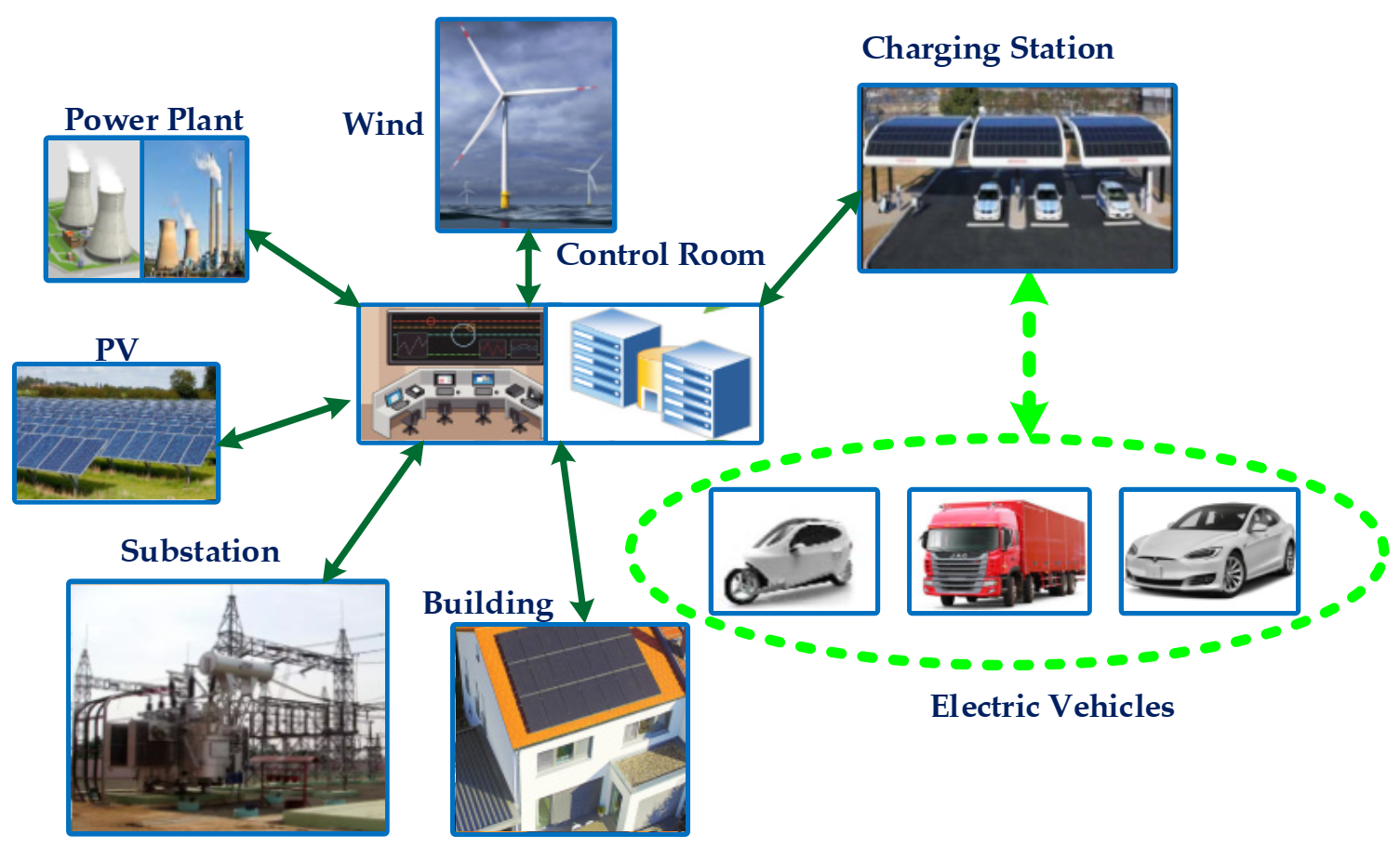
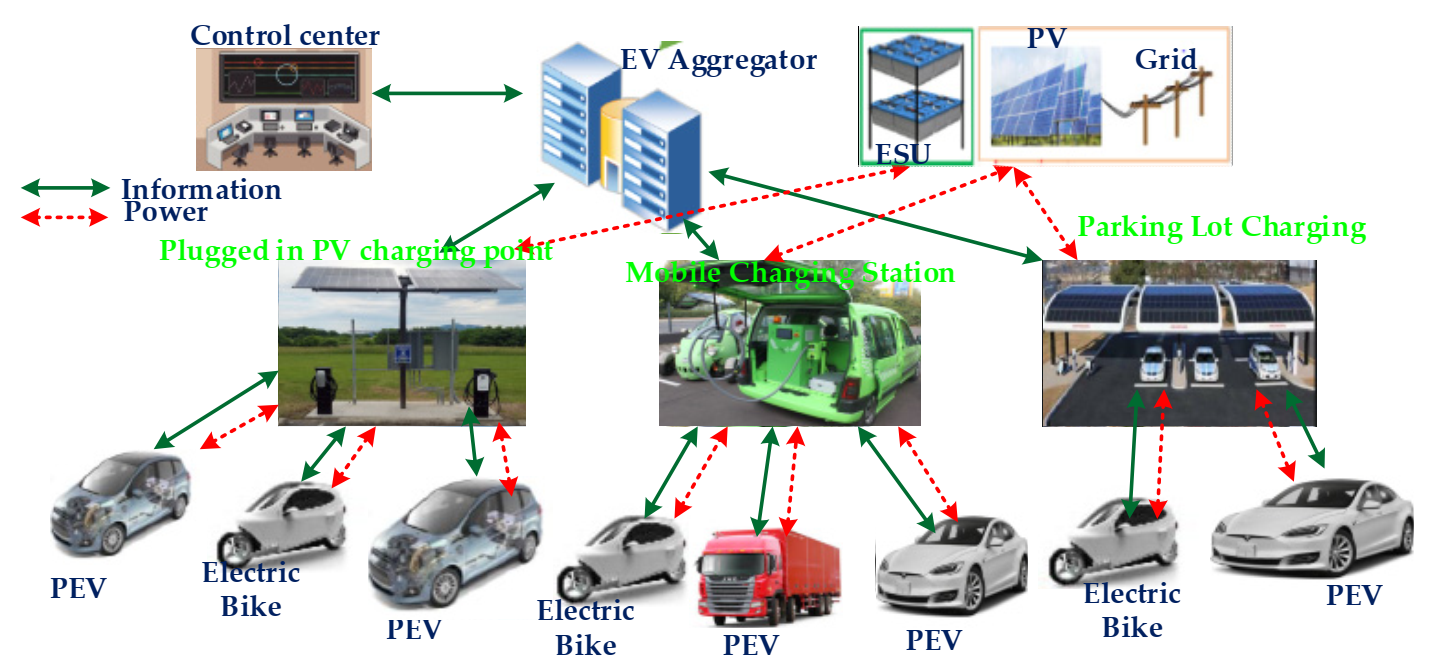








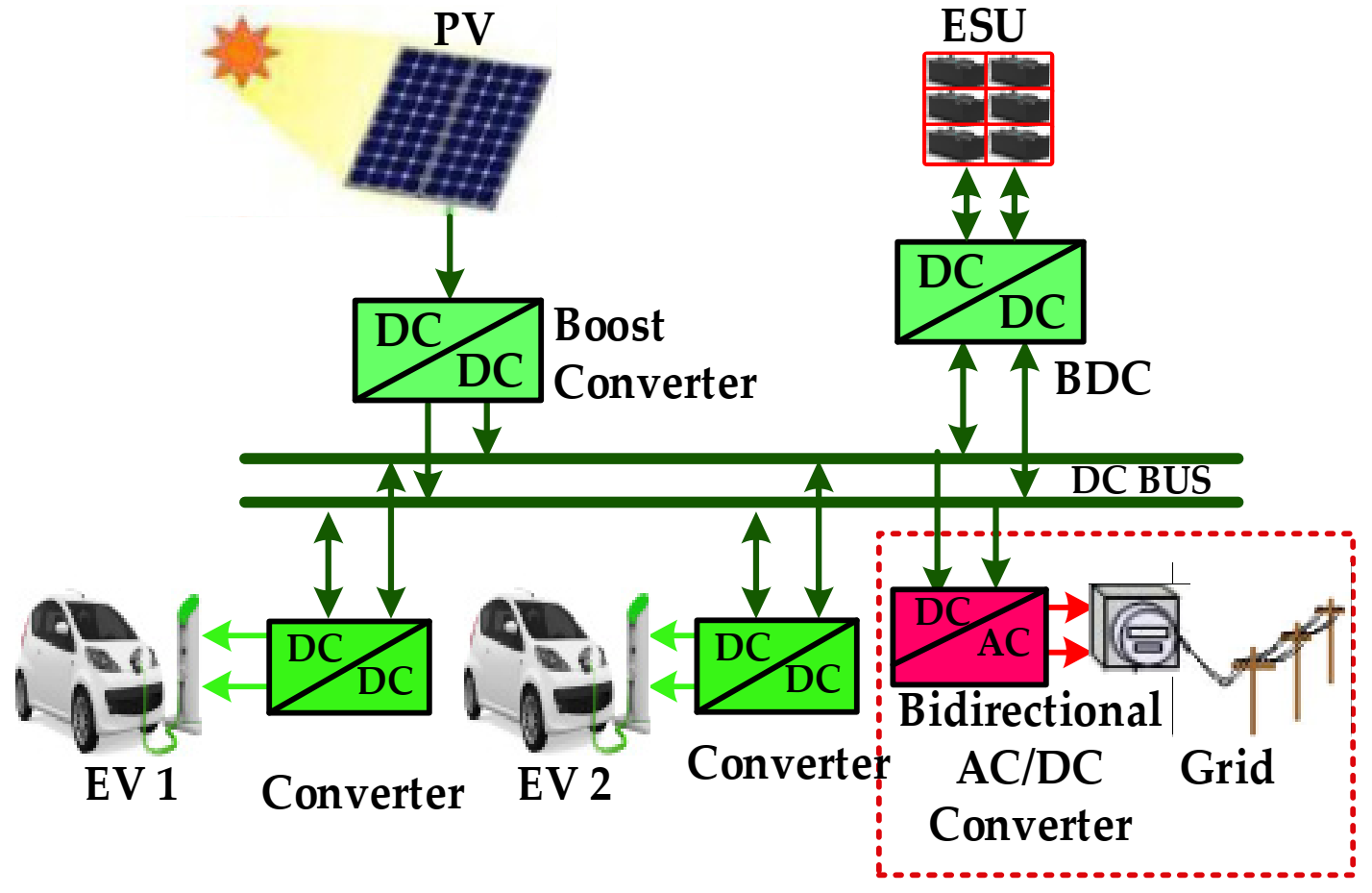








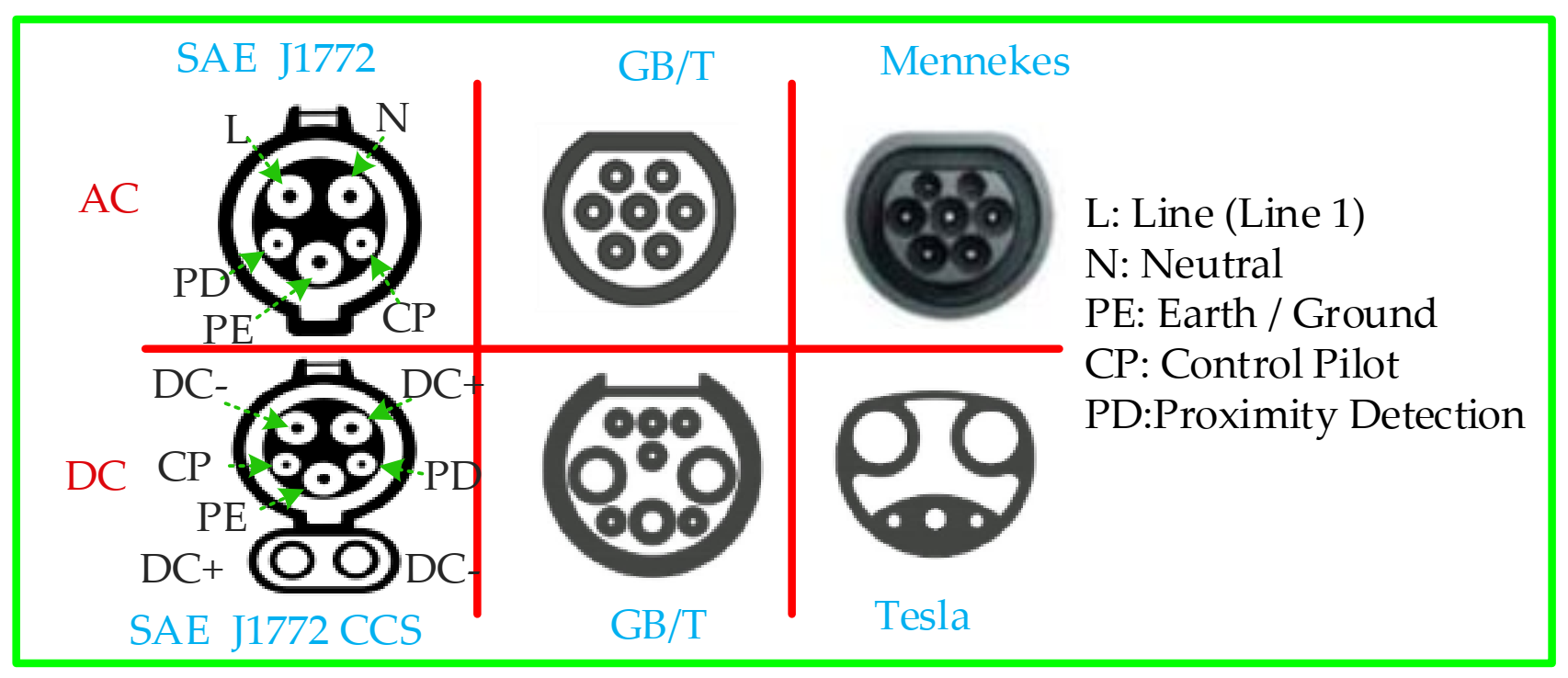
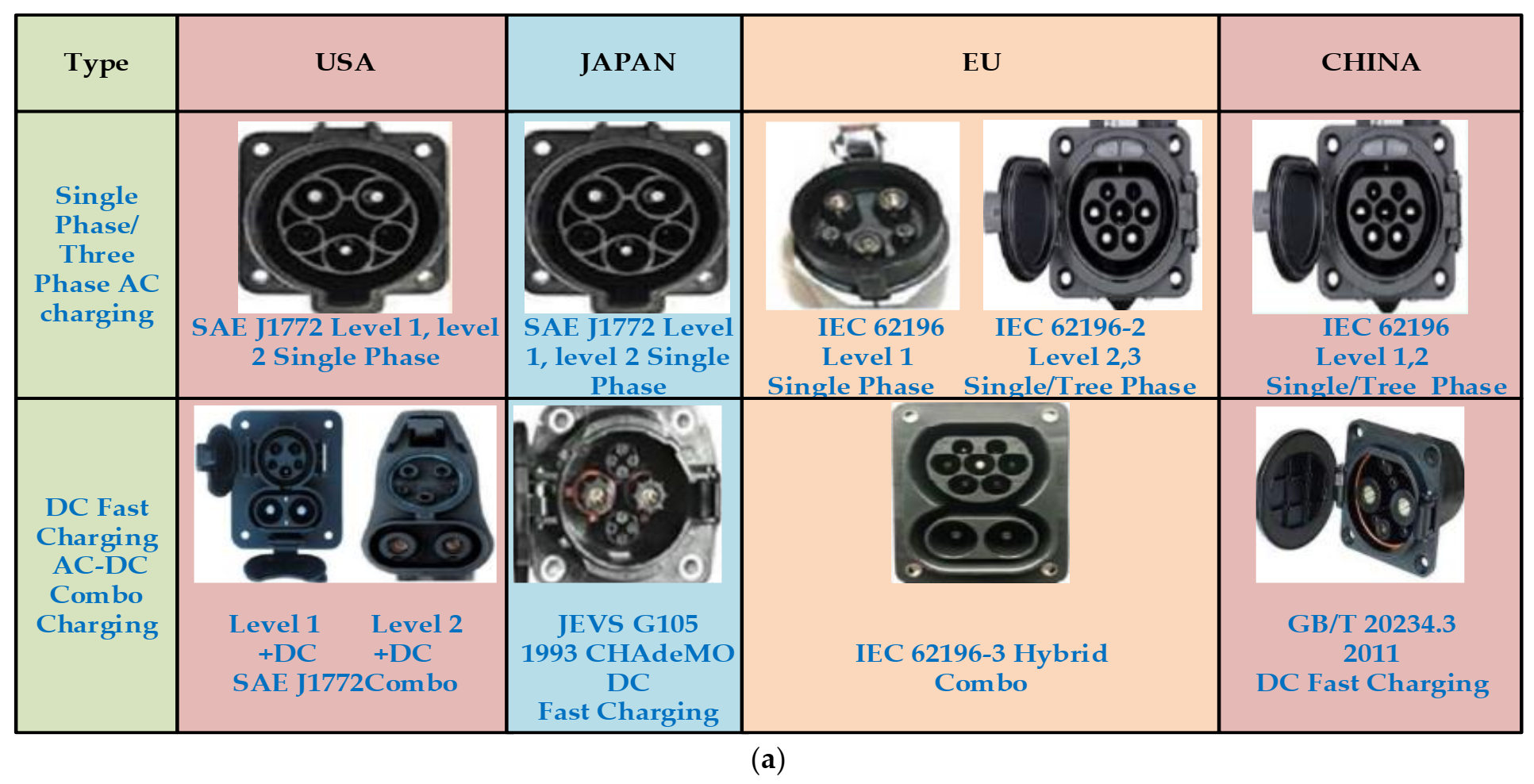

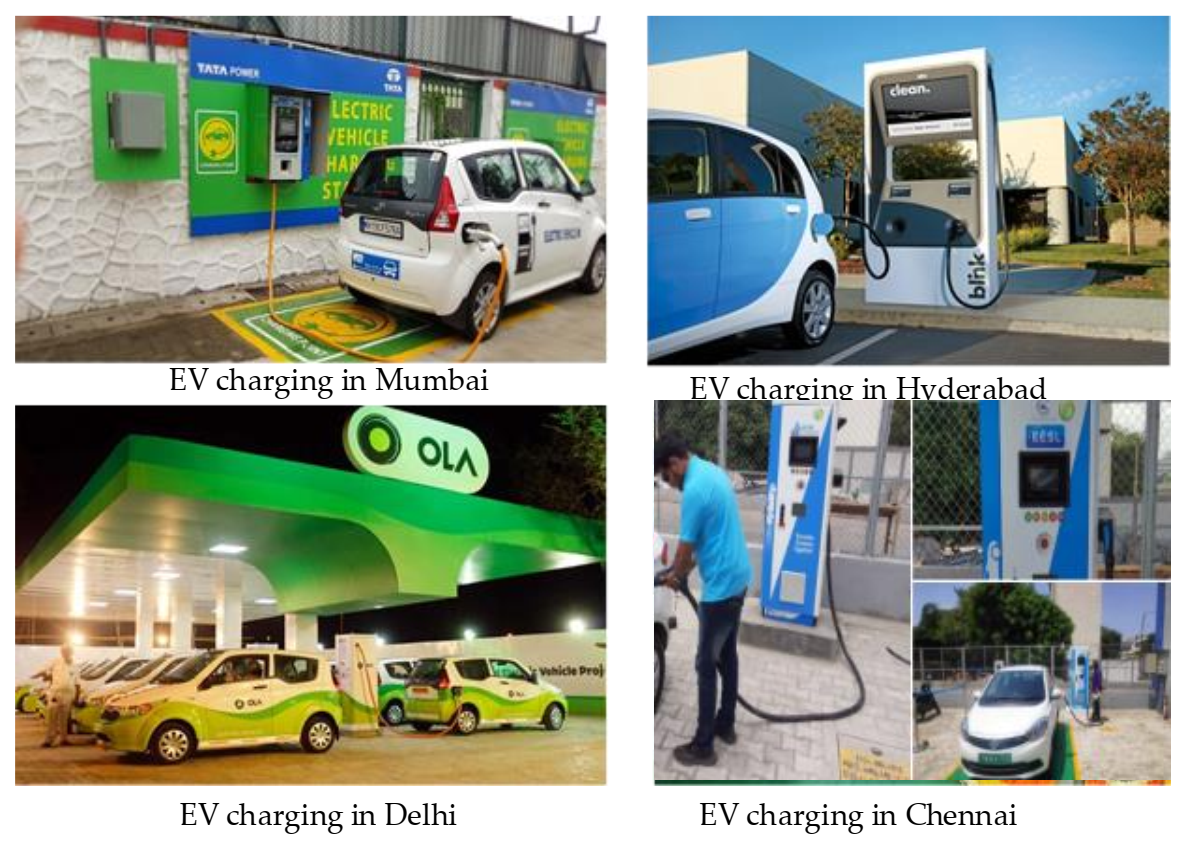
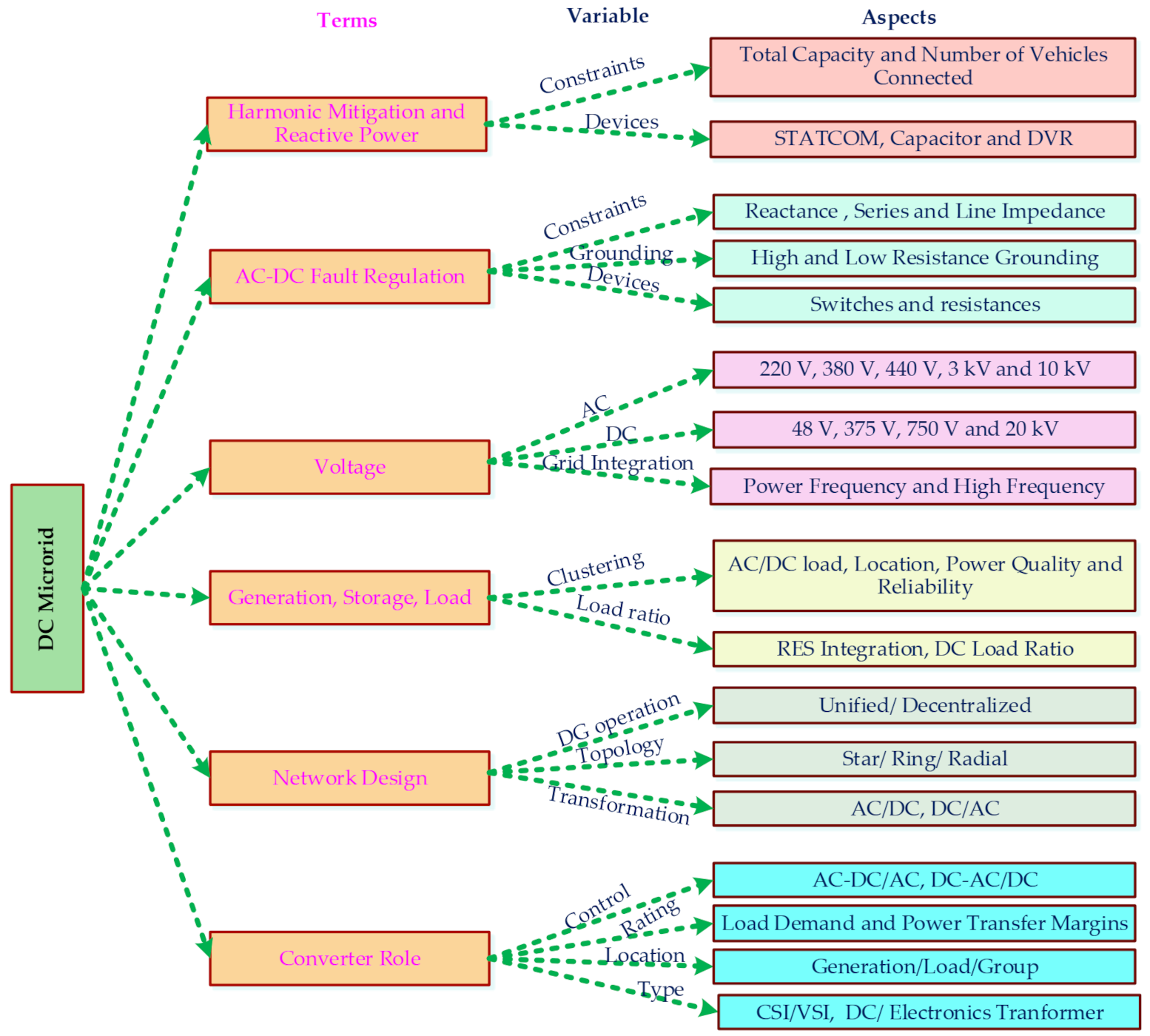
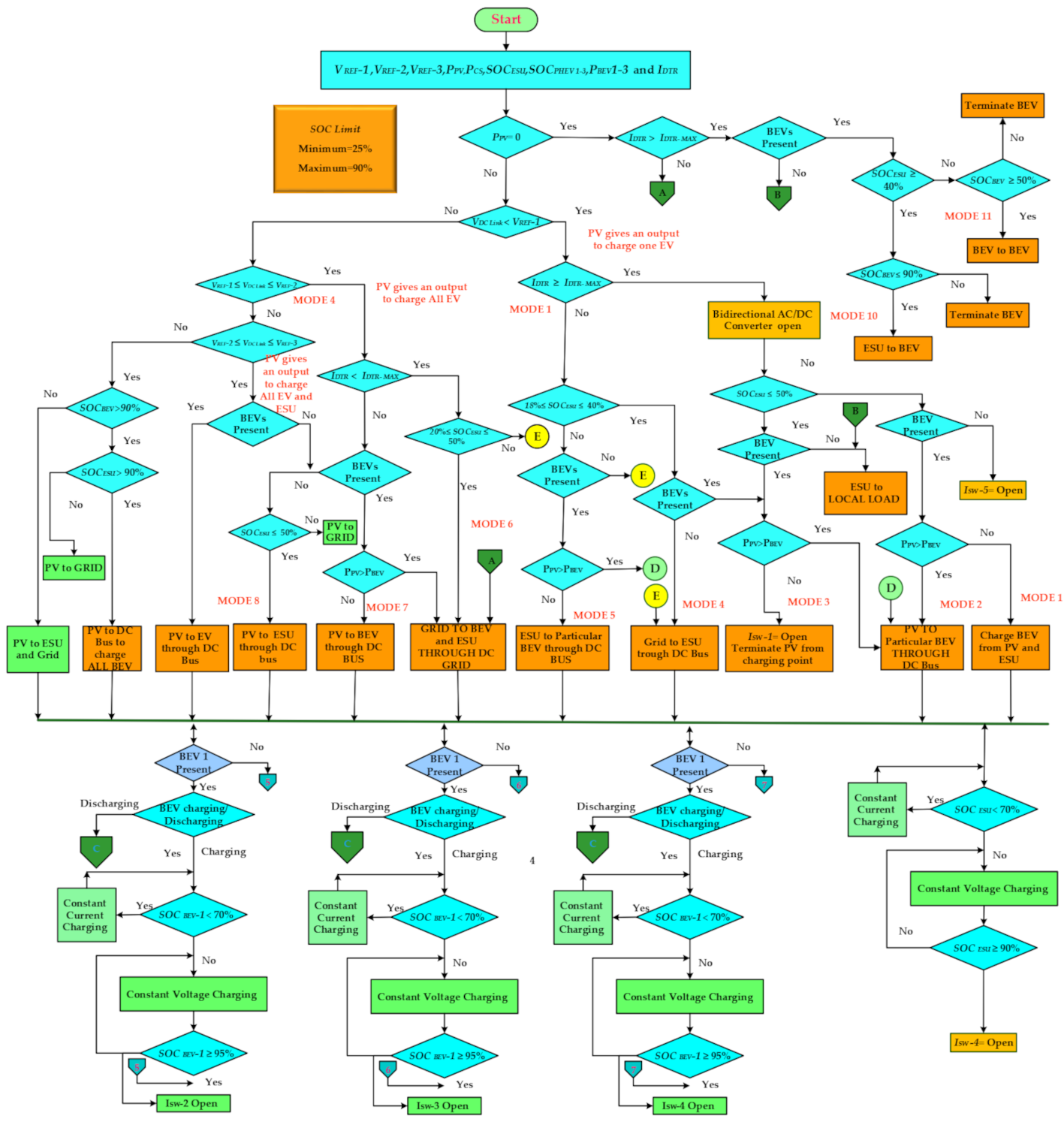

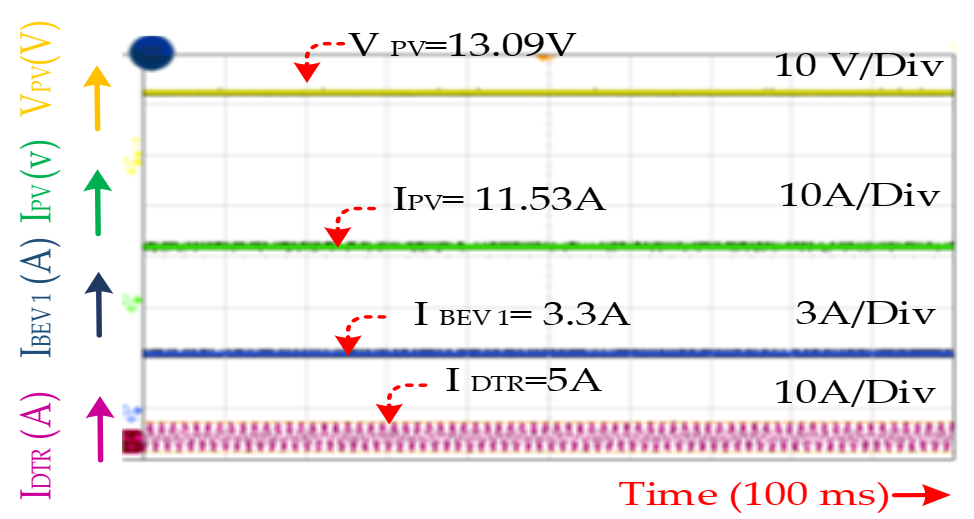

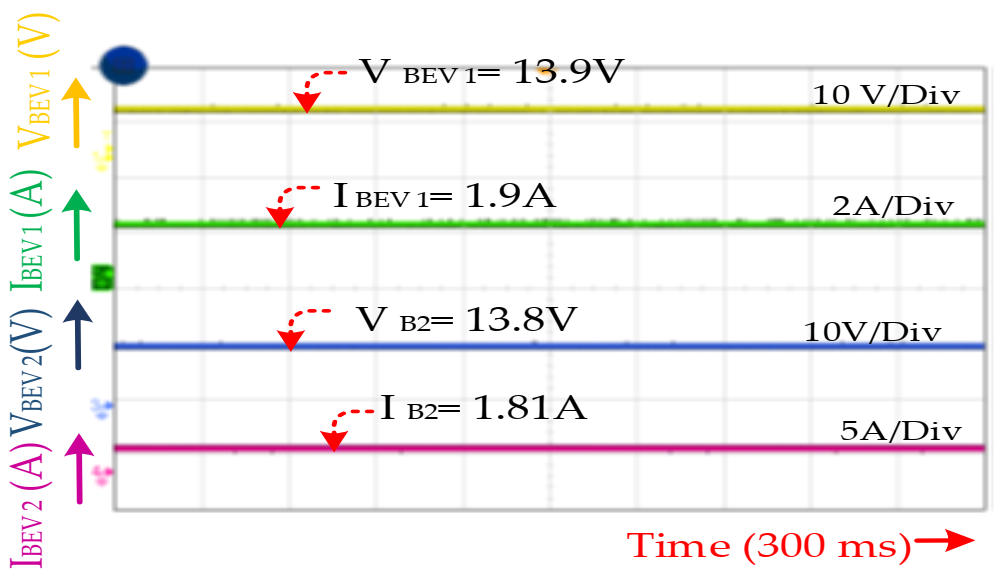
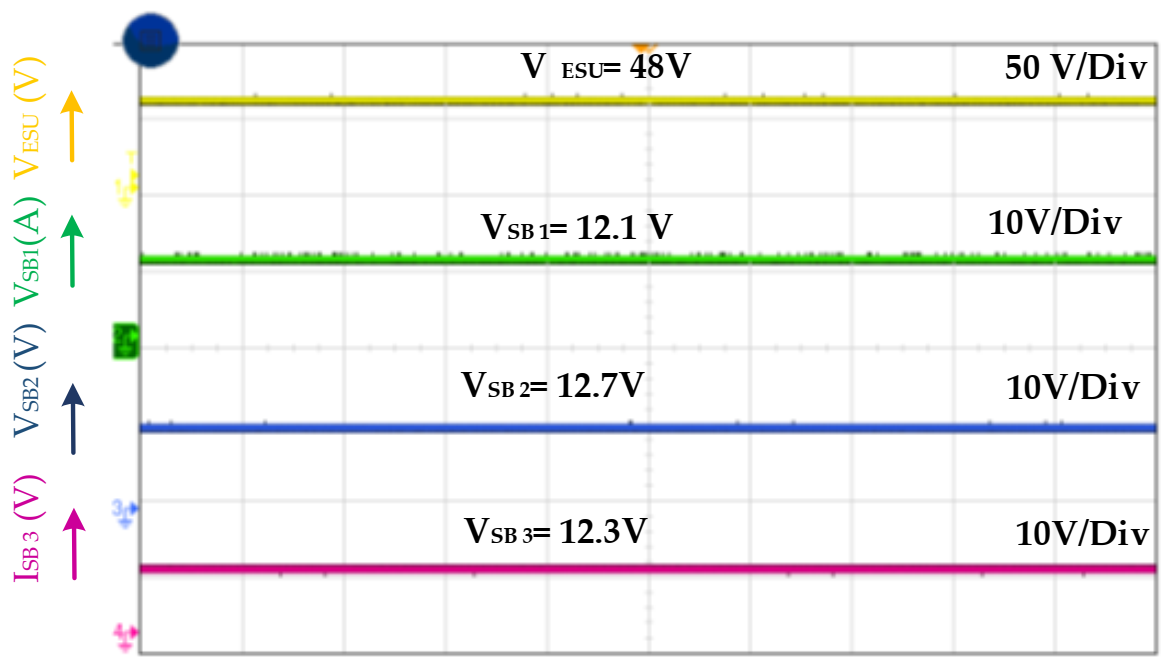
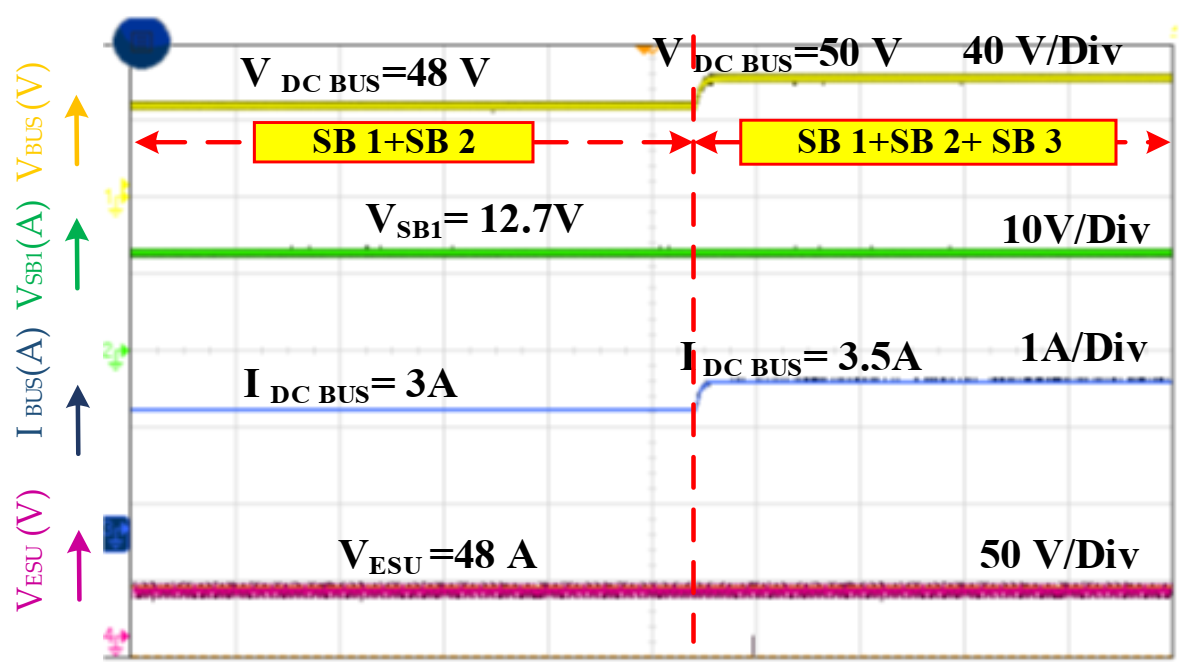

| Charging System | Pros | Cons |
|---|---|---|
| Conductive charging | Suitable for slow and fast charging High-efficient charging Multiple taping possible | Need of standard connectors and cable Requires complex charging infrastructure |
| Wireless charging | No problems in standardization of connectors Dynamic charging can be implemented Charging can be done in all climate conditions | Coil type needs to be standardized Cost of coil increases vehicle price Complexity increases on the location of the transmitter Losses are more in wireless charging |
| Battery swapping | Battery replacement done in less than a minute With the help of swapping, distance travel is increased. | Standardization required for battery size and type Charging station should be able to manage a larger number of batteries User responsible for battery maintenance |
| Charger Type | Benefits and Uses | Challenges |
|---|---|---|
| On-board | Charge possible at any location with an electric outlet Simple BMS can be used | Slow charging, less power transfer at a time Difficult to implement vehicle-to anything charging Weight of charger added to the EV |
| Off-board | Used in higher power rating (kW) Fast charging Does not add to vehicle weight | Battery heating issue Difficult to allocate places Cost of charging is high |
| Reference | Sources | Microgrid Control | Load Control |
|---|---|---|---|
| [61] | Solar | PI controller-based control for charging and MPPT-based control for PV to DC bus side | Proportional integral PWM generation-based first quadrant-based DC to DC converter |
| [62] | PV Wind, Fuel cell | Simulation dynamic optimization SDO-based sizing for complete microgrid control | Dynamic wireless power transfer (DWPT) systems for dynamic charging |
| [63] | PV, micro turbine | Rule-based algorithm with dynamic load modeling for microgrid control | Mixed integer linear programming for the energy storage unit |
| [38] | PV, wind and diesel generator | The elements that make up a microgrid can be optimally dimensioned and managed | Lead-acid battery-aging models and average ambient temperature and control |
| [64] | PV, wind, biomass, and diesel generator | Invasive weed optimization algorithm | Backtracking search algorithm control |
| Reference | Renewables | Microgrid Control | ESU Capacity | EV Type | EV Charging and Load Control |
|---|---|---|---|---|---|
| [71] | PV | Droop control | - | PEV | Load regulation through over-voltage and over-current regulation control |
| [50] | PV | Dynamic optimal power flow control | 1000 kWh | PEV | Smart load management control strategy based on cost estimation from generating energy and losses |
| [72] | PV | Rule-based control of DC LINK voltage | 130 Ah | PHEV | PI-PWM control of charging |
| [18] | PV | Power management control | (SMES) 6 H/300 A | EV | PI controller-based charging of EV and superconducting magnetic energy Storage (SMES) |
| [73] | PV | Circulating currents elimination | - | EV | Accumulated total neutral-point current control used to reduce voltage ripple in charging output. |
| [74] | PV, Wind | Model predictive controller (MPC) | 24 kWh | EV | Constant current and voltage loop control |
| Reference | Renewables | Microgrid Control | EV Type/Motor | EV Charging and Load Control |
|---|---|---|---|---|
| [82] | PV | DC link voltage-based control | PHEV | Control of load depends on the SOC available at the vehicle battery, based on the reference level operated in CV or CC mode |
| [83] | PV | Rule-based control | PHEV | Load current requirement is measured by power conditioner monitors |
| [84] | PV | Fuzzy logic power-flow controller | PHEV | Based on the real-time estimation of the load availability with total generating cost-based prediction control |
| [85] | PV and wind | Supervisor control | Different AC and DC loads | Custom-made supervisor control capable to efficiently administrate diverse energy |
| [66] | Wind | LabView control algorithm | Brushed PM DC motor | Relationship between frequency and DC voltage-based control |
| Reference | Renewables | Microgrid Control | Load | ESU Capacity | Load Control |
|---|---|---|---|---|---|
| [92] | PV | Two types of algorithm are used—stochastic dynamic programming (SDP) algorithm and greedy algorithm (benchmark algorithm) | EV | - | A linear regression model is used for load prediction and control |
| [93] | - | The smart metering-based microgrid control is used with Modbus on an TCP/IP connection using the internal LAN | EV | 30 kVA | An SOC prediction-based load control is followed. |
| [94] | PV | EMS is used to optimize power generation and use of different sources and loads to minimize the total cost, while satisfying the load and device constraints. | EV | Optimization | Keeping in mind the high loading impacts of the EV, typical EV-charging methods were incorporated. |
| [64] | PV and Wind | Frequency-based control | Balanced load | 7.3 MWh | The frequency and SOC-based control are used to provide high-quality power to the connected loads |
| [17] | PV&Wind | Supervisor control | Different AC & DC Load | Custom-made supervisor control capable to efficiently administrate the diverse energy forms |
| Reference | Renewables | Microgrid Control | ESU Capacity | Load Control |
|---|---|---|---|---|
| [75] | PV, wind | Power-based, rule-based control | Battery | Electromagnetic transient program |
| [106] | PV | Coordinated rule-based control with P&O MPPT | 250 kW | The direct torque (DTC) and direct power control (DPC) |
| [107] | PV, wind | Wavelet Transform and Fuzzy Control-based microgrid control. | - | The fuzzy control is adopted to optimize the energy management control of EVs |
| [108] | PV, wind, supercapacitor, and fuel cell | Pulse width modulation (PWM)-based power factor correction (PFC) control | - | Constant voltage and constant current control method |
| [109] | PV | Hybridization algorithm of Particle Swarm Optimization (PSO) and Applied Artificial Physics (APO) | - | Voltage control loop (VCL) and current control loop (CCL) |
| Ref. | Renewables | Microgrid Control | Type of EV Connected | ESU Capacity | Load Control |
|---|---|---|---|---|---|
| [114] | PV | Power balance control using the state diagram method | EV | - | This involves DC-based charging with Chademo and the Combined Charging Standard (CCS). |
| [115] | PV | DC link voltage-based converter control | EV | 2 kW | PI control of charging point |
| [29] | - | PWM-based bidirectional converter control | Battery storage | 2.16 kWh | Inductively coupled power transfer (ICPT)-based pulse charging |
| [116] | PV | MPPT controller | Battery storage | - | Different operating modes manage the charging |
| [117] | PV | PWM control | Battery Bank | - | Conventional current hysteresis control method |
| Reference | Renewables | Microgrid Control | Type of EV Connected | ESU Capacity | Load Control |
|---|---|---|---|---|---|
| [91] | PV | Rule-based control with PSO-based microgrid control | EV1 | 150 kW | SOC-based charging control |
| [121] | - | The power flow to all the port is connected through the high frequency link transformer | EV1 | 5 kW | PWM-based control strategy used for EV charging by controlling gate pulse. |
| [122] | PV | MPPT control | - | 10 kW | PWM-based control strategy |
| [123] | PV | MPPT control | - | 3.3 kW | Current sharing algorithm. |
| [124] | PV | Power flow | - | - | Rule-based control |
| Microgrid Architecture | Isolated DC Microgrid | Grid Connected RES Powered DC Microgrid | DC Microgrid with Direct Connections of ESU | AC Bus Charging Station Architecture | Hybrid AC-DC Microgrid | Multiport Converter with DC Grid Interconnection | Multiport Converter with AC Grid Interconnection Grid |
|---|---|---|---|---|---|---|---|
| Direct DC charging (with no AC conversion) | Yes | Yes | Yes | No | Yes | Yes | Yes |
| Direct AC usage for local load | No | Yes | Yes | Yes | Yes | Yes | Yes |
| Feasible low amount of conversion losses during V2Any (Vehicle and Grid) | Yes | Yes | Yes | No | No | Yes | Yes |
| Fast charging and discharging of ESU | Yes | Yes | No | No | Yes | Yes | Yes |
| Used for high power rating | Yes | Yes | Yes | Yes | Yes | No | No |
| Reliability | Medium | High | High | Low | Low | Medium | Medium |
| Scalability | Medium | High | Medium | High | Low | Medium | Medium |
| Stability | Stable | Stable | Stable | Stable | Unstable | Stable | Stable |
| Standard | Scope | Type | Year |
|---|---|---|---|
| SAE J1772 | Define connectors for AC charging | Conductive | 2010 |
| SAE J2293-2 | Communication network between electric vehicle supply equipment (EVSE) and EV; this communication follows an Enhanced Transmission Selection (ETS) network. | Conductive | 2014 |
| SAE J2847-1 | Provides standard communication between the utility grid and plug-in electric vehicles. | Conductive | 2010 |
| SAE J2847-2 | This standard defines an off-board conductive DC charger and its communication with plug-in electric vehicles. | Conductive and Inductive | 2015 |
| SAE J2954 | This defines a wireless power transfer of all types of plug-in electric vehicles and its coil alignment methodology | Inductive | 2020 |
| IEC 61980-3 | Defines the magnetic field-based wireless power system and its specific requirements. | Inductive | 2019 |
| IEC TS 62840-1 | Gives a general overview for battery swap systems | Battery swapping | 2016 |
| IEC 61851-1 | Defines EVSE when it is charging from the voltage range of 1000V to 1500V AC or DC, including on-board rechargeable energy storage systems (RESS) | Conductive | 2017 |
| IEC 61851-21-1 | Defines requirements for conductive connection of an electric vehicle (EV) to an AC or DC supply | Conductive | 2017 |
| IEC 61851-24 | Defines a digital communication between a DC charging station and an EV | Conductive | 2014 |
| IEC 60364 | Describes power generation and distribution of electrical charging station installations in buildings | Conductive &Inductive | 2017 |
| IEE2030.1.1-2015 | DC quick charger for use with electric vehicles | Fast charging | 2016 |
| GB/T 29317 | The terminology of electric vehicle charging/battery swap infrastructure | Battery swapping | 2012 |
| Levels | Supply Type | Voltage Range | Current Range | Power Output | PEV Charging Time | Types of Chargers | EV Connector |
|---|---|---|---|---|---|---|---|
| AC Level 1 | Single phase AC | 120 V 240 V | 16 A 13–16 A | 1.9 kW 3 kW | 7 h | On-board | J1772™/AC |
| AC Level 2 | Single/three phase AC | 208–240 V | 80 A | 20 kW | 3 h | On-board | J1772™/AC |
| AC Level 3 | three phase AC/Como charging | 300–600 V | 400 A max | 120–240 kW | 30 min | On-board | CHAdeMO |
| DC Level 1 | DC | 200–500 V | <80 A | 40 kW | 22 min | Off-board | J1772™/AC |
| DC Level 2 | DC | 200–500 V | <200 A | 100 kW | 10 min | Off-board | CHAdeMO/DC SAE/DC |
| DC Level 3 | DC | 200–600 V | <400 A | 240 kW | 30 min | Off-board | CHAdeMO/DC SAE/DC |
| Reference | Converter | Control | Feature |
|---|---|---|---|
| [135,141,142] | 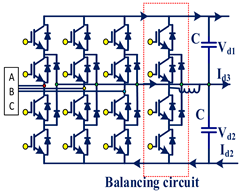 Three-Level Three-Phase NPC Converter | Voltage Oriented Control |
|
| [137,143] | 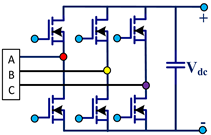 Three-phase bridgeless boost converter | Sliding mode control |
|
| [144] |  Unidirectional multilevel converter. | PWM based control |
|
| [145] |  Symmetrical two-device unidirectional boost converter | PWM based control |
|
| Ref. | Converter | Control | Feature |
|---|---|---|---|
| [146] | 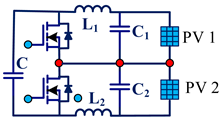 Bidirectional PV-Cuk converter | Maximum power point tracking (MPPT) |
|
| [147] |  Interleaved high gain DC-DC converter | Voltage lift technique |
|
| [113] |  Transformer less high gain boost and buck-boost DC-DC converters | Voltage control |
|
| [148] | 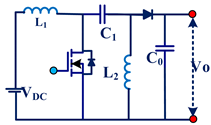 Single-Ended Primary Inductance Converter (SEPIC) | MPPT and Fuzzy |
|
| Charging Side DC-DC Converters | |||
|---|---|---|---|
| Ref | Converter | Control | Feature |
| [149,150] |  Multiple Interleaved Buck Converters | Discrete-Time Model and Direct Control |
|
| [151] | 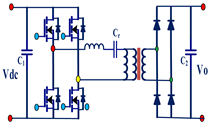 Full-Bridge LLC Resonant Converter | PFM (Pulse Frequency Modulation) and PI control. |
|
| [152] | 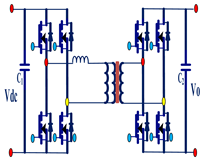 Dual Active Bridge | Current sharing control |
|
| [153] |  DC/AC/DC Converter | e PWM modulation factor value and thereby controls |
|
| [154] | 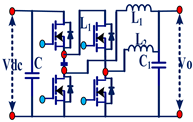 Two-Phase Series-Capacitor DC-DC Buck Converter | EnhancedI2 control |
|
| Ref. | System Architecture | Charging Station Control Strategy | Power Converter Topologies Used and Control Methodology |
|---|---|---|---|
| [159,160] | Isolated DC microgrid for EV-charging | Rule-based control using power balancing control, optimal power self-scheduling of power balancing control | A dedicated DC-DC converter is used. Differential evaluation based on SOC predicted that charging minimizes total energy cost |
| [86,161,162] | Grid-connected RES powered DC microgrid for EV-charging | PV-based battery charging stations considering service availability, DC link power predictive model (PPM) for charging station control | Dual stage-controlled DC-DC converter along with the optimization algorithm for charging |
| [163] | RES-powered DC microgrid with ESU | DC link voltage-based control | Dedicated DC-DC converter for PHEVs charging; it uses minimum energy from the utility grid |
| [164,165] | AC bus-coupled charging station architecture | Control area network (CAN) -based charging station control | Charging of EV with AC-DC bidirectional converters; it works in both inverter and rectifying mode |
| [166,167] | Hybrid AC-DC Microgrid | Power oscillation damping control implemented for both ESU and other devices connected to the microgrid | SOC-based charging of EV is done based on DC link voltage and is controlled through a DC-DC converter. Charging and discharging of ESU operates inner current loop control outer voltage/frequency control |
| [168,169,170] | Multiport converter-based DC micro grid | DC bus voltage is maintained through the PI and fuzzy controller. | Two loop control of battery charging is followed as constant current and constant voltage control |
| [171] | Multiport converter-based AC micro grid | Dual active bridge-based, control-based current sharing error compensation | Dual output port controlled for charging based on the realized DC voltage |
| Parameters | DC Bus Voltage | Capacity of Wind Generator | Capacity of PV Panel | Capacity of Fuel Cell Power | Battery Type | Battery Capacity | DC-DC Converter | Lamp Loads | Load Bus | Diesel Generator | Maximum Current |
|---|---|---|---|---|---|---|---|---|---|---|---|
| Specification | 24 V | 200 W | 200 W | 100 W | Tall tubular C10 | 14 Ah/12 V | 24 V/220 V | 500 W | 220 V | 500 W | 3 A |
| Time | PV Power (W) | Wind Power (W) | Fuel Cell Power (W) | Loads (W) | Batteries | ||||||||||
|---|---|---|---|---|---|---|---|---|---|---|---|---|---|---|---|
| Generated Power (W) | Priority Load | Commercial Load | Net Lads | Priority Load | Commercial Load | ||||||||||
| P (W) | I (A) | P (W) | I (A) | P (W) | I (A) | P (W) | I (A) | P (W) | I (A) | P (W) | I (A) | ||||
| 8 p.m.–12 a.m. | 0 | 150 | 100 | 250 | 1.13 | 100 | 0.5 | 250 | 1.1 | 350 | 1.6 | 100 | 0.5 | 100 | 0.45 |
| 9 a.m.–10 a.m. | 200 | 140 | 100 | 440 | 2 | 100 | 0.5 | 340 | 1.5 | 440 | 2 | −100 | −0.5 | 0 | 0 |
| 7 a.m.–8 a.m. | 100 | 170 | 100 | 370 | 1.68 | 100 | 0.5 | 150 | 0.7 | 250 | 1.2 | −100 | −0.5 | −120 | −0.7 |
Publisher’s Note: MDPI stays neutral with regard to jurisdictional claims in published maps and institutional affiliations. |
© 2021 by the authors. Licensee MDPI, Basel, Switzerland. This article is an open access article distributed under the terms and conditions of the Creative Commons Attribution (CC BY) license (https://creativecommons.org/licenses/by/4.0/).
Share and Cite
Savio Abraham, D.; Verma, R.; Kanagaraj, L.; Giri Thulasi Raman, S.R.; Rajamanickam, N.; Chokkalingam, B.; Marimuthu Sekar, K.; Mihet-Popa, L. Electric Vehicles Charging Stations’ Architectures, Criteria, Power Converters, and Control Strategies in Microgrids. Electronics 2021, 10, 1895. https://doi.org/10.3390/electronics10161895
Savio Abraham D, Verma R, Kanagaraj L, Giri Thulasi Raman SR, Rajamanickam N, Chokkalingam B, Marimuthu Sekar K, Mihet-Popa L. Electric Vehicles Charging Stations’ Architectures, Criteria, Power Converters, and Control Strategies in Microgrids. Electronics. 2021; 10(16):1895. https://doi.org/10.3390/electronics10161895
Chicago/Turabian StyleSavio Abraham, Dominic, Rajesh Verma, Lakshmikhandan Kanagaraj, Sundar Rajan Giri Thulasi Raman, Narayanamoorthi Rajamanickam, Bharatiraja Chokkalingam, Kamalesh Marimuthu Sekar, and Lucian Mihet-Popa. 2021. "Electric Vehicles Charging Stations’ Architectures, Criteria, Power Converters, and Control Strategies in Microgrids" Electronics 10, no. 16: 1895. https://doi.org/10.3390/electronics10161895
APA StyleSavio Abraham, D., Verma, R., Kanagaraj, L., Giri Thulasi Raman, S. R., Rajamanickam, N., Chokkalingam, B., Marimuthu Sekar, K., & Mihet-Popa, L. (2021). Electric Vehicles Charging Stations’ Architectures, Criteria, Power Converters, and Control Strategies in Microgrids. Electronics, 10(16), 1895. https://doi.org/10.3390/electronics10161895








